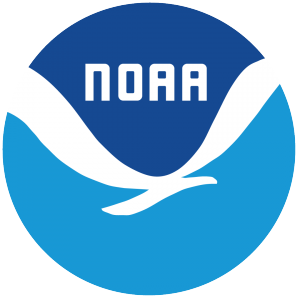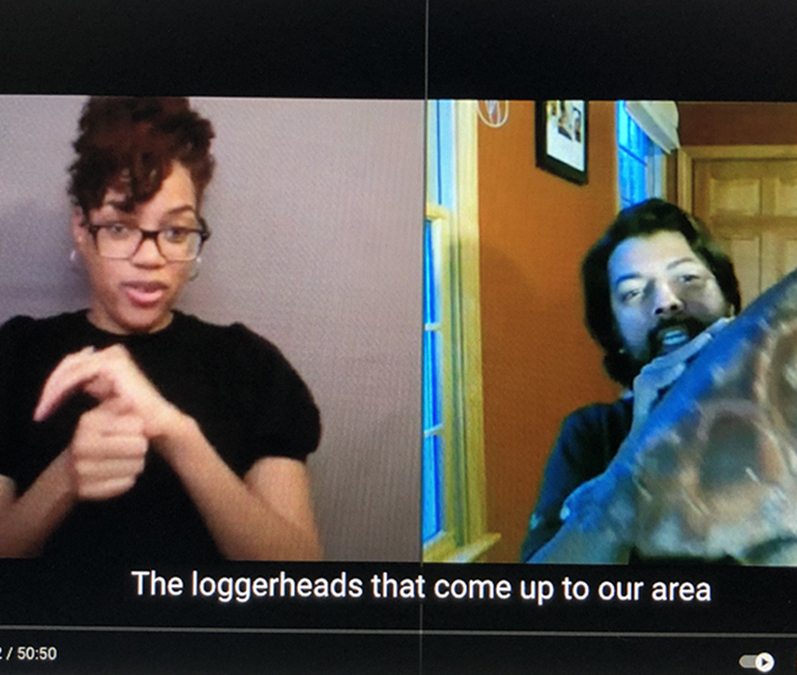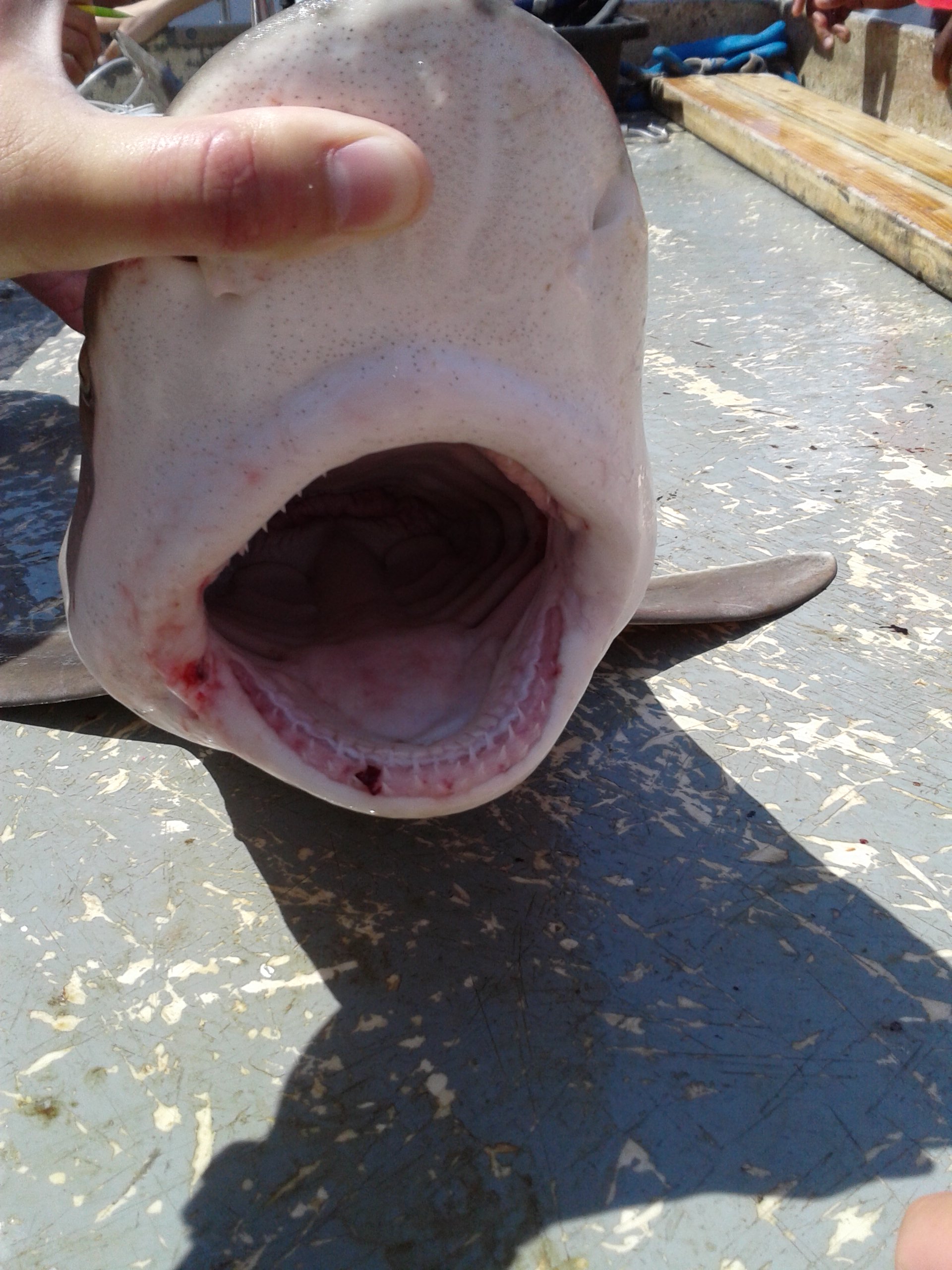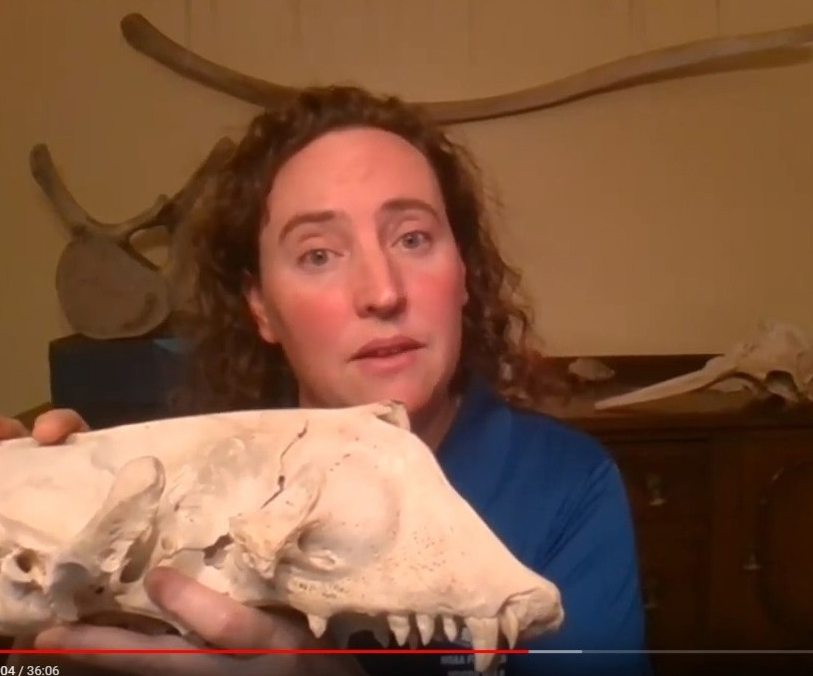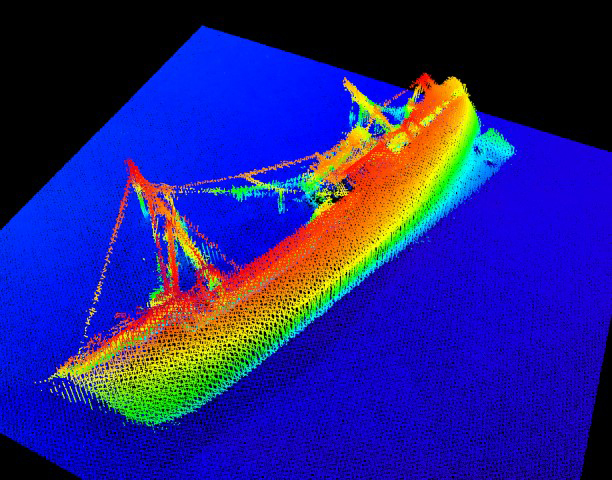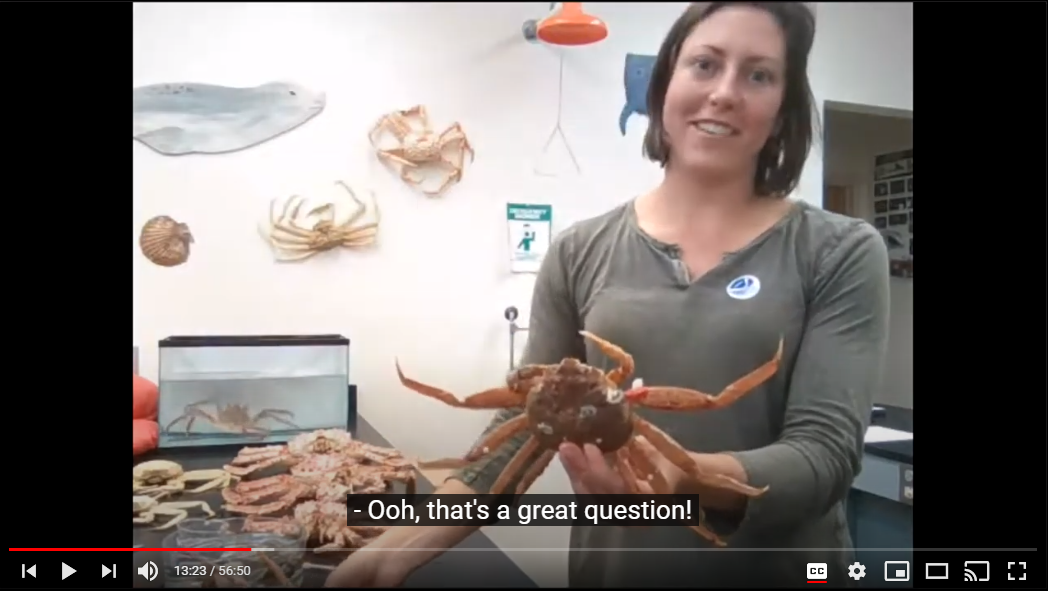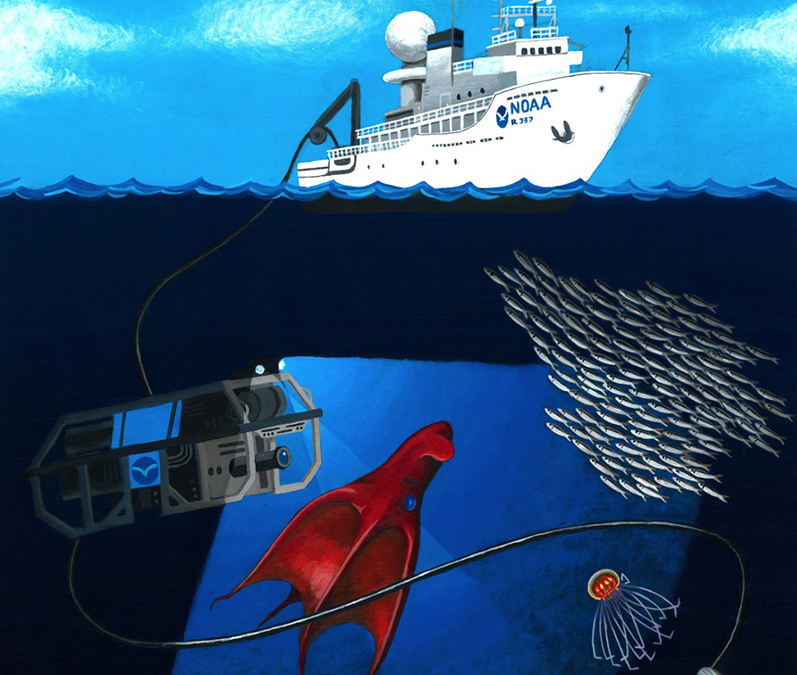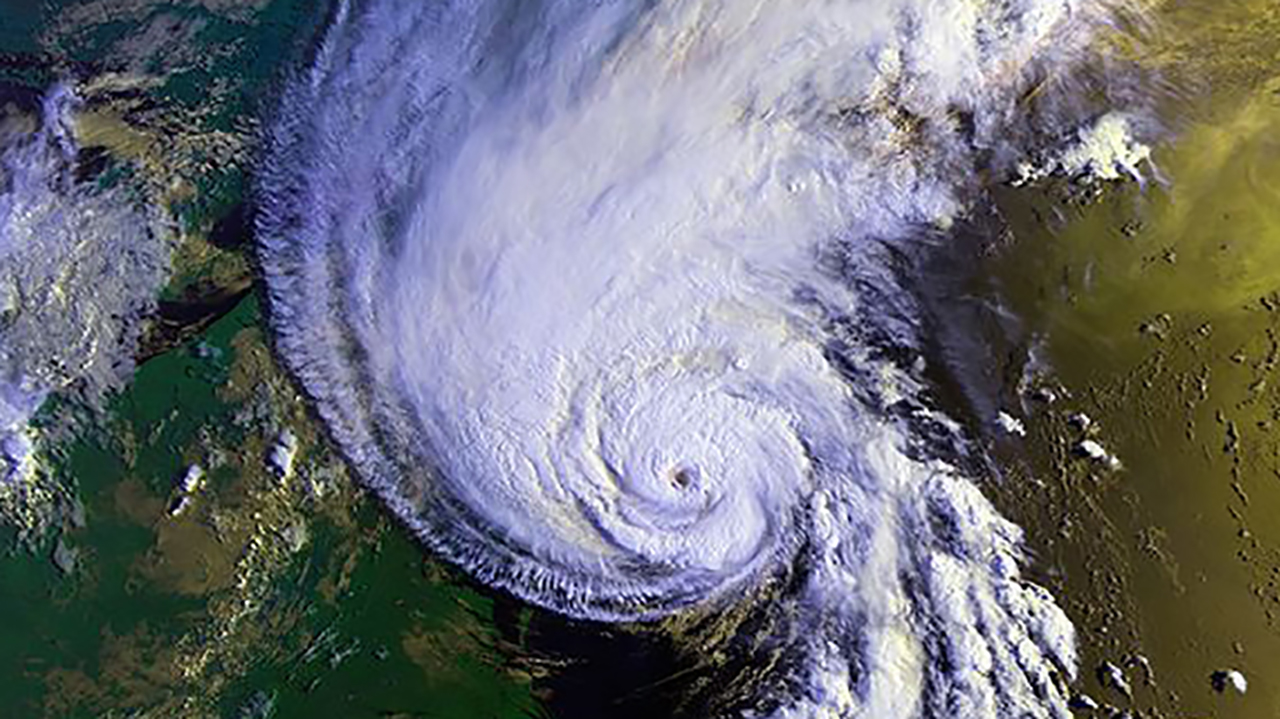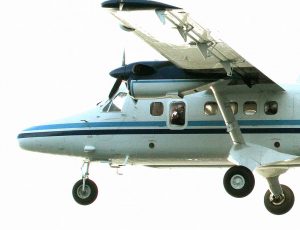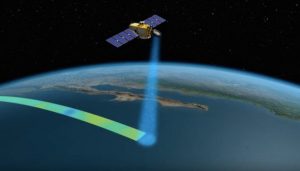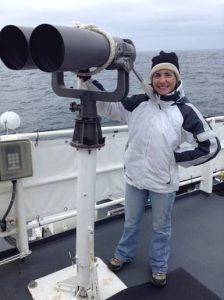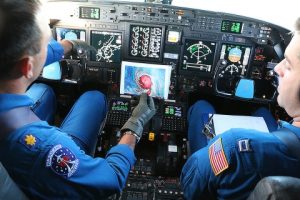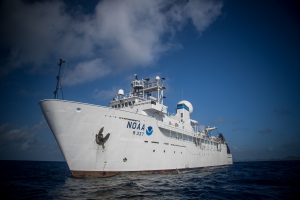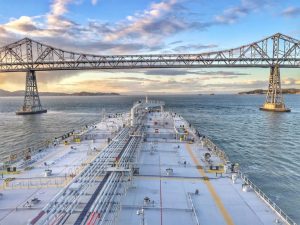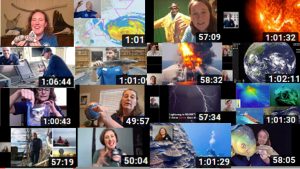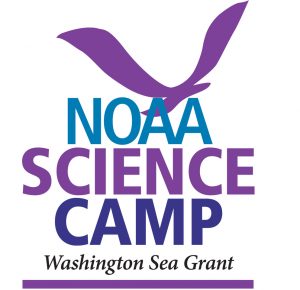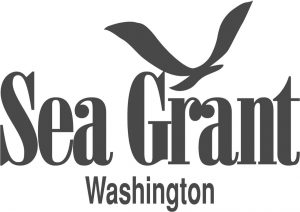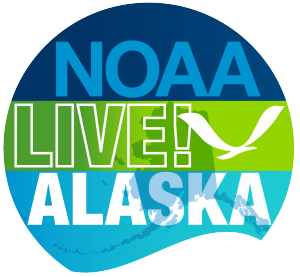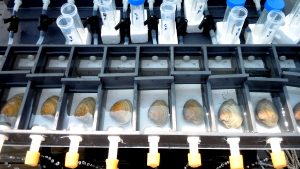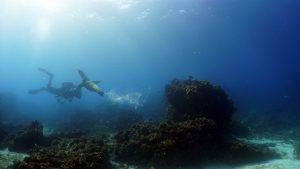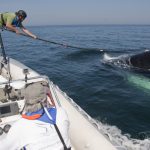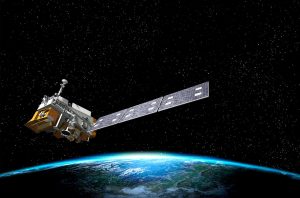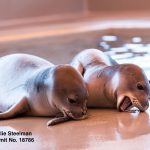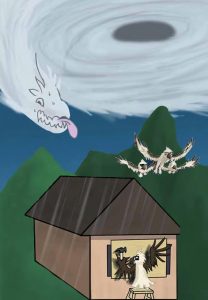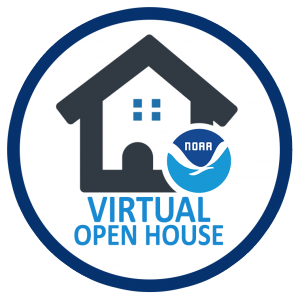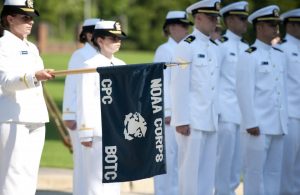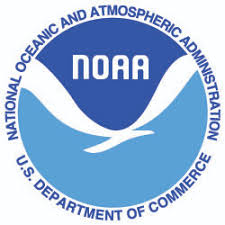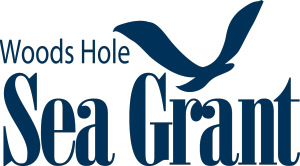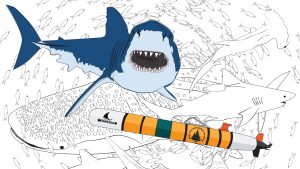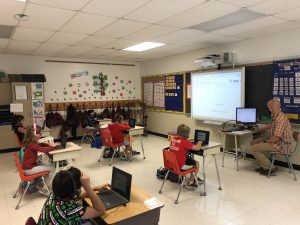Features
• Different NOAA expert and topic with each webinar
• Moderated Q&A webinars with the scientists
• Geared toward Grades 2-8
• Archive of past webinars with English captions and Spanish subtitles
• Why do we make an Indigenous Land Acknowledgment?
• FREE NOAA Live! iron-on patch. Fill out this form to get it in the mail.
Sponsors
• National Oceanic and Atmospheric Administration
• Woods Hole Sea Grant
• Woods Hole Oceanographic Institution
Follow Us on Social Media! #NOAALive4Kids
Join Us for Our Next Webinar!
That's a Wrap!
Don't forget to sign up for our iron-on patch if you are one of our NOAA Live! viewers and please take a look at our recorded webinars below for summer viewing
Past Webinars, Links and Resources
View the entire playlist of NOAA Live! webinars
Monday, March 23, 2020, at 11 am ET
Marine Mammals in Our Backyard with Grace Simpkins, Woods Hole Sea Grant and Northeast Fisheries Science Center in Woods Hole, MA
Whales are among the largest and oldest animals on earth and belong to a group of marine mammals called cetaceans. Seals are known to be the clowns of the sea and belong to a group of marine mammals called pinnipeds. Interested in learning more about marine mammals? Tune in to find out what makes a mammal a mammal and fun facts about those found around Cape Cod. (Grades 2-6) » View recorded webinar (subtitles available in English and Spanish)
Resources to access at home:
» Southern Ocean seal monitoring: Help monitor populations of seals across the world by tagging time-lapse and drone photographs.
» NOAA Office of Education: This resource collection on marine mammals includes valuable videos, background, activities, and more.
» Science Kids: Plant & Animal Differences Game - This game allows you to sort plants and animals into different categories such as birds, insects, mammals, etc.
» NOAA Fisheries Office of Protected Resources: Whale species information pages.
» Explore.org: watch orcas, manatees, belugas, gray seals, and more (some cameras may only function during a certain season). Explore with dozens of other live cams!
» NOAA Ocean Today: Learn about some of the many species in your local waters and all over the world. Fun and informative 2-minute videos from learning about the North Atlantic right whales to feeding giant octopuses!
» NOAA Ocean Today Endangered Ocean: There are several short videos on topics ranging from the endangered species act, manatees, North Atlantic right whales, and more.
Wednesday, March 25, 2020, at 11 am ET
A Bird's Eye View of Whales with Allison Henry, NOAA's Northeast Fisheries Science Center in Woods Hole, MA
Whales are among the largest and oldest animals on earth and belong to a group of marine mammals called cetaceans. Talk to a member of NOAA's North Atlantic right whale aerial survey team and learn how they do science from the sky. (Grades 2-6) » View recorded webinar (subtitles available in English and Spanish)
Resources to access at home:
» Picture Matching- Right Whales: COAST Program activity used in our lesson to match North Atlantic right whale drawings to the real right whale picture. Answer key
» North Atlantic right whale catalog: The catalog contains all the photographed sitings of right whales from the North Atlantic.
» Right Whale Listening Network: Learn about North Atlantic Right Whales and how acoustic buoys can help prevent ship strikes.
» Northeast Regional Office- North Atlantic right whale lesson: Discover the world of the North Atlantic right whale through lessons and activities on the biology, ecology, and conservation of this endangered species (Grades 6-8).
» NOAA Right Whale Sighting Advisory System - Interactive map of North Atlantic right whale sightings.
» National Geographic- Blue Whale Migration Activity: This activity allows you to map blue whale migration and develop stories to explain their behavior.
» NOAA Ocean Today Endangered Ocean: There are several short videos on topics ranging from the endangered species act, manatees, North Atlantic right whales, and more.
Friday, March 27, 2020, at 11 am ET
The Ocean From Space with Cara Wilson, NOAA's Southwest Fisheries Science Center in Monterey, CA
Satellites are amazing tools for observing the Earth and the big blue ocean that covers more than 70 percent of our planet. Scientists use data collected by satellites to monitor physical and biological changes in the ocean. Meet one of NOAA's satellite oceanographers, who will describe some of the things we have learned about our oceans by observing them from space. (Grades 3-6 but Grades 7-8 will like the topic too)
» View recorded webinar (subtitles available in English and Spanish)
Resources to access at home:
» NOAA Science on a Sphere (SOS) Explorer Mobile: Download this free app from the Apple app store or google play to explore earth and space from anywhere.
» NOAA and NASA's Geostationary Operational Environmental Satellites (GOES): Games, apps, and models to explore! Step by step instructions on how to build your own Lego GOES-R model!
» NOAA and NASA's SciJinks, It's All About the Weather: Satellites, atmosphere, tides and oceans, weather and more. There are games, videos, and a lot of information including a tornado simulator.
» NOAA Satellite Data Sets (ERDDAP): For older students who love data!
Monday, March 30, 2020, at 11 am ET
Onward and Downward! Exploring the Deep Ocean with Catalina Martinez, NOAA's Office of Exploration and Research (OER) in Narragansett, RI
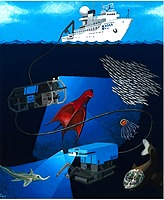
Resources to access at home:
» Nautilus Live: Explore the ocean with Dr. Robert Ballard and the Corps of Exploration. View photos, videos, and more from Nautilus expeditions.
» Inner Space Center: A diverse team of ocean scientists, engineers, educators, and video producers at the University of Rhode Island's ISC to share underwater exploration in real time. Access live video feeds and a video gallery.
» NOAA National Centers for Environmental Information Story Map: Understanding Our Ocean with Water-Column Sonar Data
» NOAA Office of Ocean Exploration and Research teams up with Octonauts. Check out Octonauts and NOAA Ship Okeanos Explorer!
» An article and 13-minute video- Ten years of collection ocean exploration data from the NOAA ship Okeanos Explorer.
» NOAA Ocean Today Ocean Exploration and Bioluminescence: There are several short videos here.
Wednesday, April 1, 2020, at 11 am ET
When Thunder Roars, Go Indoors with Glenn Field, NOAA's National Weather Service in Boston/Norton, MA

Resources to access at home:
» Follow up questions can be directed to glenn.field@noaa.gov The lightning strike band concert video he showed can be viewed here.
» National Weather Service: Lightning safety tips and resources.
» National Lightning Safety Council: They promote lightning safety and awareness.
» NOAA's National Severe Storms Laboratory: Severe weather 101 including lightning types.
Friday, April 3, 2020, at 11 am ET
Can You Hear Me Now? Marine Mammals and Sound with Genevieve Davis, NOAA's Northeast Fisheries Science Center in Woods Hole, MA
Have you ever wondered what a humpback whale sounds like? How dolphins communicate? Learn from a member of our bioacoustics team about how sound travels through the ocean, what makes underwater sounds and how we listen in. Discover why marine mammals make sound and how we use their sounds in marine mammal conservation (and hear some pretty cool sounds). (Grades 2-6 but all ages will enjoy)
» View recorded webinar (subtitles available in English and Spanish)
Resources to access at home:
» Visit the NFSC sounds page to listen to marine mammals and learn more about them.
» Right Whale Listening Network: Learn about North Atlantic Right Whales and how acoustic buoys can help prevent ship strikes.
» Voice in the Sea Call Matching Game
» Discovery of Sound in the Sea (DOSITS): A plethora of information, videos, and resources about the science and uses of sound in the sea.
» Macaulay Library: Cornell University's extensive archive of audio and video recordings for all types of animals.
» Noise Tube: You can use your smartphone to monitor noise pollution yourself by participating in this research project started at the Sony Computer Science Laboratory Paris.
Monday, April 6, 2020, at 11 am ET
Saildrones - Sailing the Seas for Science with Heather Tabisola, NOAA's Pacific Marine Environmental Laboratory in Seattle, WA
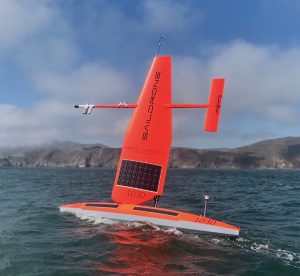
» View recorded webinar (subtitles available in English and Spanish)
Resources to access at home:
»Since 2015, the Innovative Technology for Arctic Exploration program at PMEL has kept a blog during the saildrone Arctic field season, you can find 2019's here: https://www.pmel.noaa.
» NOAA Saildrone Research 2016 - Live Broadcast Kickoff: https://youtu.be/EholPRD-UJ4
» Experience the Saildrone Antarctic Circumnavigation with your students via a series of classroom lessons developed by Saildrone and the 1851 Trust, an innovative UK education charity committed to inspiring young people to become innovators of the future and stewards of the environment. Each lesson is tailored to fit into any STEM curriculum and supported by Saildrone’s live mission updates and regular blog posts. The lessons are free for use by teachers and educators. https://www.
» Several science blogs on saildrones:
Detecting Fish from Ocean-Going Robots to Complement Ship-Based Surveys, Detecting Fish from Ocean-Going Robots to Complement Ship-Based Surveys, Unmanned Surface Vehicles Track Marine Mammals on Extended Foraging Trips for the First Time, and Saildrones Head to the Arctic for an Arctic cod survey
Wednesday, April 8, 2020, at 11 am ET
Hunting Hurricanes with a NOAA Pilot with Commander Jason R. Mansour, NOAA, Aircraft Operations Center in Lakeland, FL
NOAA Corps officers serve on the sea, on land, and in the air to support NOAA's science and stewardship mission. While most pilots try to avoid flying an airplane into severe weather, NOAA Hurricane Hunters fly specially equipped aircraft into, above, and around the eye of the storm to collect crucial data that improves forecasts and helps protect lives and property. Meet one of our NOAA commissioned officers and hear about his experiences flying scientists into hurricanes. The webinar will last about 45 minutes and will be streamed via GoToWebinar with moderated questions and answers throughout. This webinar will be recorded and posted afterward. (Grade 2-6 but all ages will enjoy) » View recorded webinar (subtitles available in English and Spanish)
Resources to access at home:
» Virtual walkthrough of the NOAA Gulfstream IV
» NOAA Aircraft Operations Center
» NOAA Commissioned Corps
» NOAA National Hurricane Center
» NOAA Ocean Today Hurricane Safe Videos: There are 8 short videos- Fuel for the storm, The making of a superstorm, Hurricane survival guide, Getting ready for hurricanes, and more.
Friday, April 10, 2020, at 11 am ET
Welcome Aboard! with Commander Colin Little, Acting Commanding Officer aboard NOAA Ship Okeanos Explorer currently moored in Norfolk, VA
This webinar will introduce you to another one of NOAA's commissioned officers and a day in his life aboard the NOAA Ship Okeanos Explorer, one of 16 research vessels in NOAA's fleet, dedicated to exploration and discovery. Tour the bridge, mess deck, galley, staterooms, engine room, and more. (Grades 2-6 but all ages will enjoy) » View recorded webinar (subtitles available in English and Spanish)
Resources to access at home:
» Okeanos Explorer Home Page with information about the ship, the team, and expeditions.
» Submersibles Page. Commander Colin mentions remotely operated vehicles in his talk and you can learn all about them here!
» NOAA Office of Ocean Exploration and Research teams up with Octonauts. Check out Octonauts and NOAA Ship Okeanos Explorer!
» Tour of the Okeanos Explorer (6 minutes)
Monday, April 13, 2020, at 2 pm ET - Alaska Week
Flying Beneath the Clouds at the Edge of the World with Katie Sweeney, NOAA's Marine Mammal Lab in the Alaska Fisheries Science Center in Seattle, WA
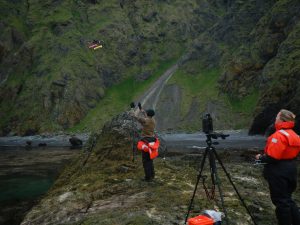
» View recorded webinar (subtitles available in English and Spanish)
Resources to access at home:
» Video that shows how the hex drone works (Katie uses this video in her webinar)
» Southern Ocean seal monitoring: Help monitor populations of seals across the world by tagging time-lapse and drone photographs.
» Science blogs on using drones:
Fur seals on Bogoslof Island: Post 4- Evolving Science on an Evolving Island - Katie's team tested two camera systems on drones on Bogoslof Island in Alaska in September 2019
New Drone Technology Could Revolutionize Marine Mammal Monitoring
Investigating Steller Sea Lion Declines on Remote Aleutian Islands - Science Blog - fieldwork from 2016
Endangered Steller Sea Lions Get a Closer Look from Online Community of Citizen Scientists
Association for Unmanned Vehicle Systems International - Student Unmanned Aerial Systems Competition
Examples of using Unmanned Aerial Systems in NOAA research - NOAA Unmanned Aerial Systems Program
Wednesday, April 15, 2020, at 2 pm ET - Alaska Week
Talking Trash with Peter Murphy, NOAA's Marine Debris Program Alaska Regional Coordinator in Seattle, WA
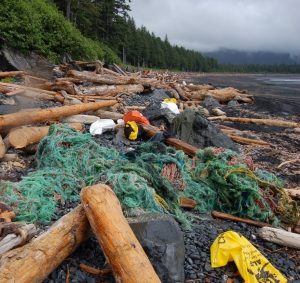
Resources to access at home:
» NOAA Marine Debris Program games and activities for kids of all ages + posters and fact sheets
» NOAA Trash Talk - short videos on marine debris and what you can do.
» Marine Debris in Alaska
» NOAA Marine Debris Program in Your Region - Find your regional coordinator as well as state or region-specific information on current marine debris projects and activities.
» NOAA Ocean Today Trash Talk Videos: There are 11 short videos- What is marine debris, where does marine debris come from, impacts of marine debris, and more.
Friday, April 17, 2020, at 2 pm ET - Alaska Week
Uncovering the Seafloor: Charting Alaska's Waters with Lieutenant (junior grade) Michelle Levano and Pete Holmberg, both from NOAA's Office of Coast Survey in Seattle, WA

» View recorded webinar (subtitles available in English and Spanish)
Resources to access at home:
» NOAA Office of Coast Survey educational activities. Explore the depths of the ocean with animations, interactive games, activities, coloring pages, and more. This includes "seafloor mapping" and "ocean in a bottle" activities.
» How to make a sounding box activity.
» Finding nautical charts.
» Search for a shipwreck game.
» StoryMap on charting in Alaska
Monday, April 20, 2020, at 11 am ET
Leaping for Atlantic salmon: Protecting endangered species with Sarah Bailey, NOAA's Greater Atlantic Regional Fisheries Office in Orono, ME
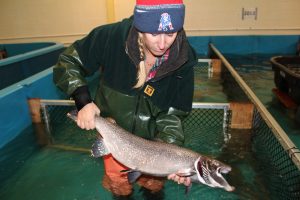
Resources to access at home:
» Northeast Fisheries Science Center: Salmon Team: This is the Northeast Salmon Team website and has important information about the work being done by the group.
» NOAA Species in the Spotlight video on Atlantic salmon.
» Sea-Run, Go! Wild Atlantic salmon app for classrooms and home. After watching Sarah's webinar you are ready to play! This activity comes with Sea-Run, Go! QR cards that you print out and place around your house! Tape the QR codes up around your house or yard and then have your child play through the app. They go through 11 challenges (QR codes) and get points. They can even compete with their friends (that do the challenges at their own houses).
» U.S. Fish and Wildlife: Teaching kids about fish migration. There is a fun lesson, "Designing fish-friendly culverts (and bridges)" lesson for grades 5-8.
» U.S. Fish and Wildlife: Environmental education resources for teachers, parents, and kids. Activities range from the "ABCs of fishing" coloring book, word searches, migration station, and more.
Wednesday, April 22, 2020, at 11 am ET
Super Storms From the Sun?! An intro to space weather with Shawn Dahl, NOAA's National Weather Service at the Space Weather Prediction Center in Boulder, CO

Resources to access at home:
» Space Weather Prediction Center
» NASA's space weather resource site.
» Space weather impacts page.
» NASA Science Space Place where kids can explore earth and space. There are activities and experiments.
» Fun Kids digital radio and online from the UK. This has some kid friendly information about space weather as well as a podcast to listen to.
» Shawn Dahl gives a brief overview of the Space Weather Prediction Center and its activities.
Friday, April 24, 2020, at 11 am ET
Swimming Upstream with River Herring with Abigail Archer, NOAA's Woods Hole Sea Grant and Cape Cod Cooperative Extension in Barnstable, MA

Resources to access at home:
» NOAA Fisheries article, "You can help scientists count migrating river herring - virtually"
» U.S. Fish and Wildlife: Teaching kids about fish migration. There is a fun lesson, "Designing fish-friendly culverts (and bridges)" lesson for grades 5-8.
» U.S. Fish and Wildlife: Environmental education resources for teachers, parents, and kids. Activities range from the "ABCs of fishing" coloring book, word searches, migration station, and more.
» Help count the river herring:
--Mystic River, Massachusetts Herring Counter, https://www.mysticherring.org/video#/
--Town Brook, Plymouth Massachusetts Herring Counter https://www.plymouthriverherring.org/
» Watch Live Fish Cameras:
--Herring Creek on Martha’s Vineyard https://wampanoagtribe-nsn.gov/naturalresourcedepartment
--Town Brook, Plymouth Massachusetts Herring Counter https://www.plymouthriverherring.org/
Monday, April 27, 2020, at 11 am ET
Explore the World with NOAA's fun, New App with Hilary Peddicord and Beth Russell, NOAA's Earth System Research Laboratories in Boulder, CO
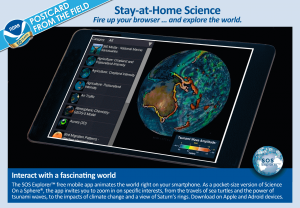
**Download the SOS Explorer in advance on your favorite mobile device if you like (just make sure you are watching the webinar on another device!)**
Resources to access at home:
» NOAA Science on a Sphere (SOS) Explorer Mobile: Download this free app from the Apple app store or google play to explore earth and space from anywhere.
Wednesday, April 29, 2020, at 11 am ET
Sharks Make Sense with Chris Flight, NOAA's Mississippi-Alabama Sea Grant Consortium at the Dauphin Island Sea Lab in Dauphin Island, AL
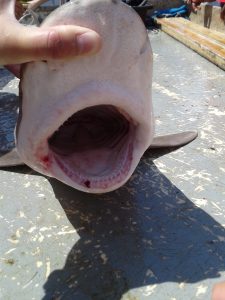
Resources to access at home:
» OCEARCH Tracker Page - This map of tagged sharks shows you real-time, up to date locations on a variety of tagged sharks
» Dauphin Island Sea Lab archived Facebook Live Events- These videos cover a variety of topics. Some examples are, stingrays, alligators, crustaceans, lionfish, and many more!
» Atlantic White Shark Conservancy - This site lists all of the AWSC shark enrichment programs during school closures.
» Shark vocabulary that Chris used during his webinar.
» NOAA story: 12 Shark Facts that May Surprise You
Friday, May 1, 2020, at 11 am ET
The Job of a NOAA Oil Spill Response Scientist with Gary Shigenaka and Charlie Henry, both of NOAA's Office of Response and Restoration in Seattle, WA and Mobile, AL
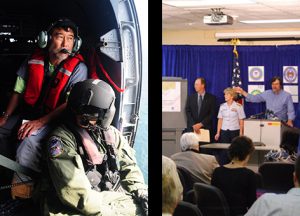
Resources to access at home:
» Restoring the Gulf: 10 Years After Deepwater Horizon Oil Spill - This NOAA article has some great information, videos, infographics, top 10 questions you might ask, and more!
» History of oil spill response at NOAA - This NOAA article gives some nice background material.
Monday, May 4, 2020, at 11 am ET
Getting Prepared for Hurricane Season with John Cangialosi, NOAA's National Hurricane Center in Miami, FL

Resources to access at home:
» Hurricanes at Home! webinar series by the National Hurricane Center. Check out these great webinars on the NHC YouTube channel. You may find one from your region! (You can find the National Hurrican Center on Facebook and Twitter too)
» National Hurricane Preparedness - This website has information on developing an evacuation plan, assembling disaster supplies, forecast information, and much more!
» NOAA Education Resources on Hurricanes - This website has information on tropical cyclones, hurricane safety, videos, satellite imagery, historical records, and much more!
» Create-A-Cane - Try to create ideal conditions for a hurricane by changing the winds, latitudes, moisture, and sea temperature. Try to get your score up to 80!
» Aim a Hurricane - How many different places can you make the hurricane strike simply by changing a few conditions?
» Find many of the resources above and a few more for teachers on the National Hurricane Center outreach page under "Opportunities for K-12 students".
» National Weather Service Website - You can look for your local weather or click on their education tab to learn weather safety with Owlie Skywarn.
» Tropical Storm and Hurricane Names - You can see if there has been a storm with your name!
» NOAA Ocean Today Hurricane Safe Videos: There are 8 short videos- Fuel for the storm, the making of a superstorm, hurricane survival guide, getting ready for hurricanes, and more.
Wednesday, May 6, 2020, at 11 am ET
Dive In and Explore Coral Reef Ecosystems with Dana Wusinich-Mendez, NOAA's Coral Reef Conservation Program in West Palm Beach, FL
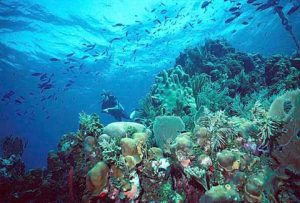
Resources to access at home:
» NOAA Coral Reef Conservation Program Education Page (Dana referred to this page and it has the 3D polyp and other activities)
» NOAA National Ocean Service Corals Tutorial
» A glimpse inside the "Valley of the Giants" shows coral heads like "Big Momma" that are protected within the National Marine Sanctuary of American Samoa on Ta'u. Big Momma is more than 500 years old and over 6 meters high, and has a circumference of 41 meters. This Porites coral may be the largest one in the world!
» Interactive Reef Virtual Dive - Explore this virtual reef and learn more about corals
» Bleached Reef Virtual Dive - In early 2015, coral bleaching started in the Airport Pool on Tutuila. This image shows the staghorn corals in the midst of the severe bleaching event.
» How do corals build their reefs? Visit this California Academy of Sciences Page to learn more. (Dana shows the video from this page during the webinar)
» The coral reef economy. NOAA's page that explains how coral reefs support jobs, tourism, and fisheries. (Dana shows the video from this page during the webinar)
» The nation's database on sustainable seafood Fishwatch.gov
» National Marine Sanctuaries Virtual Dives of different reefs
» NOAA Ocean Today Coral Comeback Videos: There are 9 short videos- Rainforests of the sea, the coral and the algae, corals under threat, what can we do, and more.
Friday, May 8, 2020, at 11 am ET
Helping Big Ships Bring Goods into Port So You Can Have What You Need with Kyle Ward and Louis Licate, NOAA's Office of Coast Survey in Charleston, SC and Miami, FL
Scientists, engineers, and mariners use NOAA’s products and services to slide underneath bridges, navigate tight turns, and dock alongside ports so that everything from groceries to games are available in stores for you to use. Come learn about how the Office of Coast Survey keeps America’s commerce moving! (Grades 2-6 but all ages will enjoy) » View recorded webinar (subtitles available in Spanish and English)
Resources to access at home:
» You can view charts in your area here: https://www.charts.noaa.
» We're all connected video that Kyle showed during the webinar
» World Map of Ship Routes YouTube Video that Kyle showed during the webinar
» Vessel Traffic Data (AIS) for US coastal waters between 2009-2017
Monday, May 11, 2020, at 11 am ET
What's in that Mouthful of Seawater: Introducing the Ocean's Microscopic World with Vera Trainer, NOAA's Northwest Fisheries Science Center in Seattle, WA
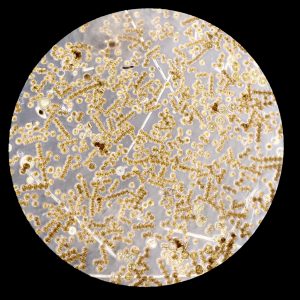
Resources to access at home:
» NOAA Northwest Fisheries Science Center's video, "Science at Sea - The Hunt for Killer Algae." (20 minutes long)
» Why Do Fish Get Sick? youtube video
» Tabs on Habs Videos- These are an introduction to Harmful Algal Blooms and their Identification. There is a beginner, intermediate, and advanced series of videos.
» The National Ocean Service's Harmful Algal Blooms (HABs) website. There is regional information so you can look up HABs in your area, resources such as how we forecast HABs, frequently asked questions, and more!
» Nature Video's "Five Reasons to Thank Plankton" that Vera showed during her webinar. Find out how much you owe these little guys.
» WHOI website on harmful algae blooms. This resource has maps, species, impacts, and more.
» Download the "Phyto" app for free on your smartphone. You can access a series of flashcards with both freshwater and marine phytoplankton. Learn to identify phytoplankton and their proper pronunciation.
Wednesday, May 13, 2020, at 11 am ET
Winged Ambassadors: Ocean Travelers with Jennifer Stock, NOAA's Cordell Bank National Marine Sanctuary in Olema, CA
Seabirds that live their entire lives at sea (except for one very special time of the year!) have tremendous stories to tell about the health and ecology of the global ocean. What makes a seabird a seabird? How do we know where they live and travel on the ocean? What does your wingspan say about you? What can you do to help seabirds? Learn about the amazing travels of Black-footed and Laysan Albatrosses in the Pacific Ocean. (Grades 2-6 but all ages will enjoy) » View recorded webinar (subtitles available in Spanish and English)
Resources to access at home:
» Dive in and find the National Marine Sanctuary closest to you.
» Storymap about Birds throughout National Marine Sanctuaries - This includes migration routes, bird research, a bird tour, an interactive bird map, and more!
» Bird Watching at Stellwagen Bank National Marine Sanctuary -This includes a guide to sanctuary birds and a chart of seasonal sightings.
» Winged Ambassadors: Ocean Literacy through the Eyes of Albatross (predominantly for teachers, but includes photos, ppts, videos) http://www.
» National Geographic's Laysan Albatross virtual bolus dissection - Kids can use online videos and photo galleries to conduct s virtual bolus dissection.
» Seabird and Shorebird Activity Book- The Hawaiian Islands Humpback Whale National Marine Sanctuary put together this fun book. Seabirds secret code, shorebirds word find, seabirds mobile, and more!
» Makani Interactive Workbook- Makani: The albatross that cares for the land- interactive story about Laysan Albatross and ocean conservation.
» Ocean Guardian Kids Club - The Kids Club offers children a stimulating opportunity to express their insights, observations, and understanding of their natural environment through the creation of original stories, poetry, and visual art. All K-8 students are eligible and encouraged to join!
» Cornell's Bird Cams: A virtual window into the natural world of birds.
» Nesting Albatross video that Jennifer shows during her presentation
» A Perfect Day for an Albatross by Caren Loebel-Fried: Download the free teacher's guide that features activities that target national science, math, writing, and art education standards for grades 1-3.
Friday, May 15, 2020, at 11 am ET
Talking Tornadoes with a Storm Researcher with Sean Waugh, NOAA's National Severe Storms Laboratory in Norman, OK
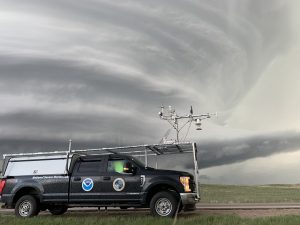
Resources to access at home:
» Sean answers all your webinar questions we didn't have time for. NOAA Live! Webinar Series Tornado FAQs
» The National Severe Storms Laboratory website on tornadoes
» The National Weather Service website on tornado safety
» NOAA Storm Prediction Center where you can look at current data and predictions
» Weather Wizkids website about tornadoes. At the bottom, you will find experiments such as how to make a tornado in a bottle, a tornado in a jar, a pressure experiment to suck an egg into a bottle, and several more.
» The National Severe Storms Laboratory Severe Weather 101 tornadoes webpage.
» Ready.gov This government website has valuable information about how to make a plan, what to put in your emergency bag, and more. Visit their Ready Kids! website for games, tips, and more!
» YouTube video of the largest tornado in recorded history - May 31st, 2013 Multi-Vortex Tornado near El Reno, OK. Sean shows a portion of this video during his talk.
Monday, May 18, 2020, at 3 pm ET
Stories in the Stone: Archaeology in Papahānaumokuākea Marine National Monument with Malia Evans, NOAA’s Papahānaumokuākea Marine National Monument in Hilo, Hawai'i
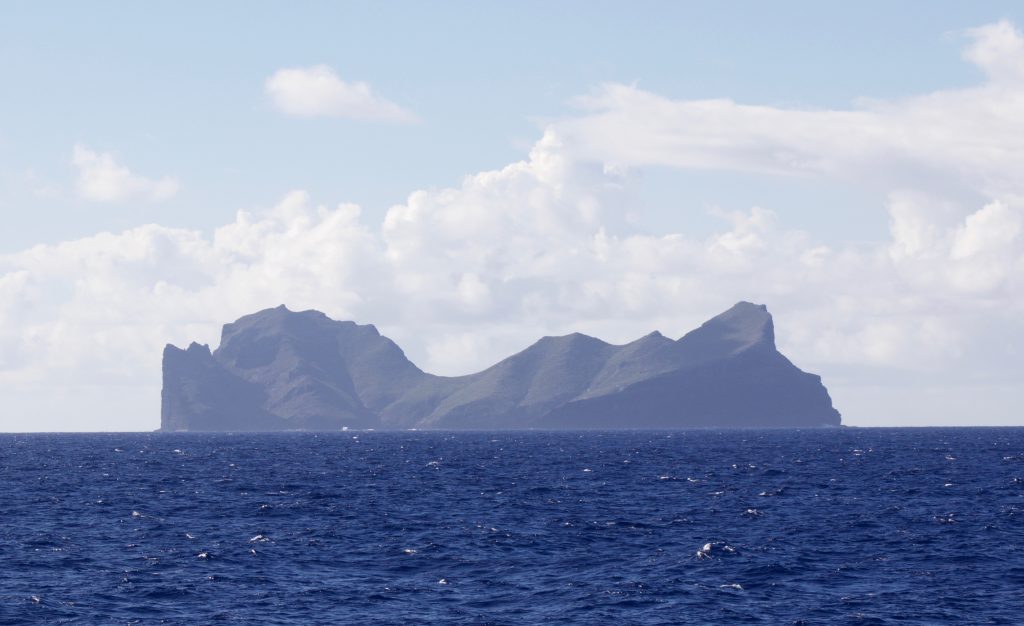
Resources to access at home:
» Native Hawaiian Cultural Heritage in the Monument
» Learn about the special name given to this unique place - You can even listen to an audio file of the pronunciation and practice at home.
» Read about Maliaʻs journey to Papahānaumokuākea in July 2019
» Kids activities and marine archaeology info - Find activity books and a shipwreck gameshow on this website.
» Downloadable Map of Papahānaumokuākea
» Learn more about Polynesian Navigation
» Visit this page for directions on how to submit a photo of your kiʻi pōhaku (petroglyphs) as well as see all the photos we received.
» Videos Malia showed during her webinar: History of Hokulea (~10 minutes), USGS Kilauea Volcano Helicopter Overflight July 21, 2018 (~1 minute), and Nihoa Island (~8 seconds)
» Papahānaumokuākea song and coloring book by Patrick Ching
» NOAA Ocean Today Adventures of a Maritime Archaeologist Videos: There are 7 short videos- What is maritime archaeology, explore with us, sanctuaries, and more.
Wednesday, May 20, 2020, at 3 pm ET
Following ‘Ō‘io: The Life of Hawaiian Bonefishes with Keith Kamikawa, NOAA Fisheries Pacific Islands Regional Office in Honolulu, Hawai'i
It’s easy to follow friends and family who are important to us through social media. But there is no Facebook for fish. So how do we keep track of fish species that are important to our fisheries? Hawai‘i is home to two species of bonefish, including one found nowhere else in the world. Let’s take a look at ‘ō‘io (bonefishes) in Hawai‘i, a favorite catch for local anglers, and follow them throughout their lives. By building their life history “profile,” we can learn how to protect their habitat and fish sustainably so that the next generation can enjoy a future where fishing traditions―and fish―thrive. (Grades 2-6 but all ages will enjoy) » View recorded webinar (subtitles available in Spanish and English)
Resources to access at home:
» Habitat Mapping Activity - Color your way through 'ō'io habitat by hand or on a computer or tablet.
» Pre-spawning aggregation video. (Keith shows a clip in the webinar)
» Bonefish Reproduction Research Project video - You can view a female releasing her eggs.
Fish with Care
» Be a FAST (Fishing Around Seals and Turtles) responder! It’s OK to call for help! If you’re not in Hawai‘i, learn about protected animals in your area and what to do if you see a stranded marine mammal or sea turtle.
» Measure your catch! Check out the Hawai‘i Nearshore Fishes Measuring Guide to figure out which fish to keep or release, or find out about fishing in your area. Download the Fish Rules App for saltwater fishing regulations in Federal and State waters from Maine to Texas.
Get to Know NOAA Habitat Restoration in Your Area
» Fish depend on healthy habitat! Check out the NOAA Habitat Restoration Atlas to find out about restoration projects in your area. The searchable map highlights projects across the nation, including community-based restoration projects.
Friday, May 22, 2020, at 3 pm ET
Minutes Matter: Nature's Warning Signs for Tsunami with Cindi Preller, NOAA's National Weather Service Pacific Tsunami Warning Center in Honolulu, Hawai'i

Resources to access at home:
» Tsunami Hazard Maps: States and territories produce maps for their coastlines that identify tsunami inundation and evacuation areas.
» Tsunami Education and Outreach Material: Resources available about tsunami safety, including a 2-minute fast draw animation.
» Pacific Tsunami Warning Center Video Playlist: Collection of videos and animations from the Pacific Tsunami Warning Center
» Tsunami FAQs
» Homeowners Handbook to Prepare for Natural Hazards
» National Ocean Service animation - Know what to do if a tsunami hits—and the risks you face. (~2 minutes long) Shown during the webinar.
» UN video, "Lessons save lives: the story of Tilly Smith". A clip of this is shown during her webinar.
» University of Alaska Earthquake Center animations. Generation of a tsunami, propagation, etc. (These are used in the webinar)
» NOAA Ocean Today Tsunami Survival Guide Videos: There are 7 short videos- Tsunami awareness, tracking tsunamis, tsunami science, and more.
Monday, May 25
Vote For Your Top 3 NOAA Live! Webinars for our All-Stars Show on Friday, June 12th
Help us pick the all-star speakers we are inviting back to answer more of your questions. Voting has ended.
Extra Credit:
» Pick your favorite past NOAA Live! webinar and watch it on YouTube or pick a new one you haven't see yet!
» Make a drawing and write down your favorite "fun fact" you learned from a NOAA Live! Webinar. E-mail it to Grace Simpkins at gsimpkins@whoi.edu but make sure it only has your first name on it.
Wednesday, May 27, 2020, at 11 am ET
Coastal Marshland in My Texas Backyard with Nikki Fitzgerald, NOAA's Texas Sea Grant in Anahuac, TX
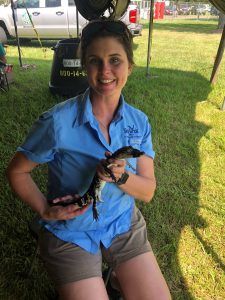
Resources to access at home:
» Texas Parks and Wildlife page on Coastal Wetlands. You can see pictures of some of the animals that live in Texas' coastal wetlands.
» Anahuac National Wildlife Refuge
» Texas Parks and Wildlife video: Gulf Coast Prairies Eco-Region (6 minutes long)
» Texas Parks and Wildlife video: Crabbing the Coast at Sea Rim State Park (3 minutes long)
» Beaumont Texas Cattail Marsh Scenic Wetlands and Boardwalk 2017 video (3 minutes long)
» Anahuac National Wildlife Refuge Travel Video (4 minutes long)
» Pond Management with Jefferson/Chambers County Agent Nikii Fitzgerald (7 minutes)
» What are watersheds? video with Nikki (5 minutes long)
» Types of weathering video with Nikki (3 minutes)
Friday, May 29, 2020, at 11 am ET
Blue Blood, Green Eggs, and Red Knots: The amazing story of the horseshoe crab with Chris Petrone, NOAA's Delaware Sea Grant in Lewes, DE

Resources to access at home:
» Delaware Sea Grant’s Horseshoe Crab 15 Second Science YouTube playlist. These short videos are fun, quick, and informative.
» Delaware Sea Grant article: Scientists develop an artificial bait that reduces the need to harvest horseshoe crabs
» The Horseshoe Crab - information about the horseshoe crab.
» The Delaware Bay Horseshoe Crab Survey
» NOAA's Ocean Today video on horseshoe crabs - “Blue Blood Battles Bacteria”
» Estuaries 101 “Hooray for Horseshoe Crabs” lesson plan
» Horseshoe Crab Origami
» Migrating Shorebirds and Horseshoe Crabs video (~36 seconds long)
» Just flip 'em music video
» Videos Chris shows during his webinar, "egg video" and "feeding video"
» NOAA Ocean Today the Remarkable Horseshoe Crab Videos: There are 5 short videos- The remarkable horseshoe crab, blue blood battles bacteria, and more.
Monday, June 1, 2020, at 11 am ET
Giant Seabass, Kings of the Kelp Forest with Ryan Freedman, NOAA's Channel Islands National Marine Sanctuary in Santa Barbara, CA
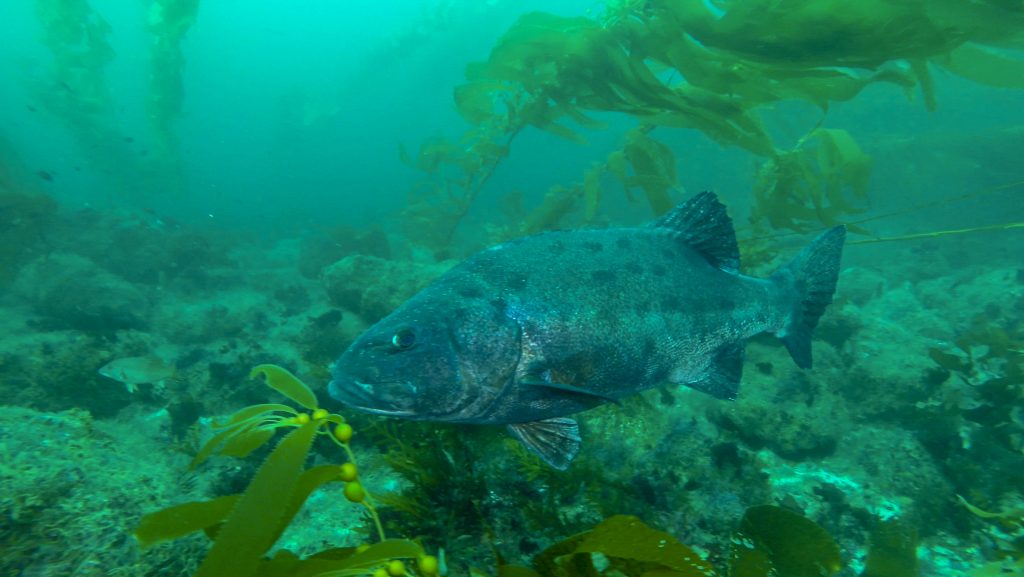
Resources to access at home:
» "Return of the King" - An article on how researchers track giant sea bass populations in the Channel Islands National Marine Sanctuary
» Channel Island National Marine Sanctuary education page. This includes an encyclopedia of sanctuaries, marine reserves interactive map, and more.
» Map of the Channel Islands National Marine Sanctuary.
Wednesday, June 3, 2020, at 11 am ET
Fishing for Food and Facts with Anna Mercer, NOAA's Northeast Fisheries Science Center in Narragansett, RI
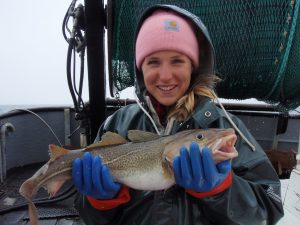
Resources to access at home:
» U.S. Seafood Facts at Fish Watch
» Fisheries of the United States
» NOAA Fisheries Cooperative Research
» National Marie Sanctuaries Fish and Fishery Facts in California. This has some great information on where fishing occurs, the different fisheries, fishing vessel types, fishing gear, seafood markets, and more.
» Seafood Nutrition Partnership Website. NOAA Fisheries is a partner and you can find seafood 101, the science of seafood, and more.
Friday, June 5, 2020, at 11 am ET
USS Monitor: Heavy Metal on the High Seas With Tane Casserley, NOAA's Monitor National Marine Sanctuary in Newport News, VA

Resources to access at home:
» This Monitor National Marine Sanctuary website has information about the science of exploration and monitoring the shipwrecks at the sanctuary.
» Explore shipwrecks from the Civil War through World War II
» Map of the Monitor National Marine Sanctuary
» Fun activities for students and all ages. Monitor bingo, a civil war crossword puzzle, test your knowledge, and much more.
» Education resources for teachers. You will find curriculum, activities, and videos here.
» Proposed sanctuary expansion Why expand? Find out more here.
» Living Shipwrecks 3D - This website gives you a 3D view (created from multibeam sonars) of various shipwrecks and the marine life that uses the sites as habitat. This was created by NOAA's Monitor National Marine Sanctuary (MNMS) and National Centers for Coastal Ocean Science (NCCOS) Beaufort Lab.
» NOAA Ocean Today Maritime Archaeology Videos: There are 8 short videos- What is maritime archaeology, explore with us, sanctuaries, and more.
Monday, June 8, 2020, at 11 am ET
From Training to Underwater Exploration: Take a Deep Dive with the NOAA Diving Center With Jessica Keller and Zachary Hileman, both from the NOAA Diving Center in Seattle, WA and Stephanie Gandulla, NOAA's Thunder Bay National Marine Sanctuary in Alpena, MI

Resources to access at home:
» Learn more about the NOAA Diving Program (NDP). View NOAA diving forms, regulations, training, and more. Click here.
» The NOAA Office of Marine and Aviation Operations website. There is a lot of information as well as featured stories and videos.
» A map of the NOAA diving program units and sub-units (where are our trained divers).
» Thunder Bay National Marine Sanctuary education website. There are links to NOAA's online games, an encyclopedia of the sanctuaries, and more.
» NOAA National Ocean Service "Dive in: underwater adventure" website. This shows you the diving opportunities in NOAA's national marine sanctuaries and estuarine research reserves.
» Map of Thunder Bay National Marine Sanctuary
» Immerse yourself in the ocean and your national marine sanctuaries without getting wet! These virtual reality voyages use 360-degree images to highlight each national marine sanctuary.
» National Park Service Junior Ranger Underwater Explorer Program.
Wednesday, June 10, 2020, at 11 am ET
Wait! Is that a Real Jellyfish? With Michael Ford, from NOAA Fisheries in Silver Spring, MD

Resources to access at home:
» The Smithsonian website on jellyfish and comb jellies. This includes their role in the food web, reproduction and life cycle, human connections, and more. Click here.
» Interesting web articles with photo and video content that Mike wrote with colleagues and folks from Ocean Exploration:
» Explorations Far Above the Musician Seamounts: A Crescendo for Midwater Explorers
» The Gelata of Océano Profundo 2015 (available in English and Spanish)
» Cyclocanna welshi
» Dive 05: Twirling Jelly
» Trawling for Plankton (and Plastic) on the Way Home from Indonesia
Friday, June 12, 2020, at 11 am ET
NOAA Live! All-Stars Show - ask the questions you didn't get answered!
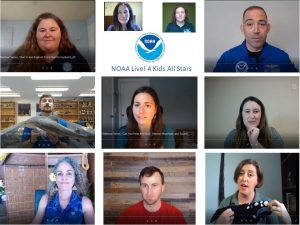
Hunting Hurricanes with Commander Jason R. Mansour, NOAA, Aircraft Operations Center in Lakeland, FL
Airplane Surveys of Whales with Allison Henry, NOAA's Northeast Fisheries Science Center in Woods Hole, MA
Archaeology at Papahānaumokuākea Marine National Monument with Malia Evans, NOAA’s Papahānaumokuākea Marine National Monument in Hilo, Hawai'i
Marine Mammals and Sound with Genevieve Davis, NOAA's Northeast Fisheries Science Center in Woods Hole, MA
Saildrones with Heather Tabisola, NOAA's Pacific Marine Environmental Laboratory in Seattle, WA
Coral Reefs with Dana Wusinich-Mendez, NOAA's Coral Reef Conservation Program in West Palm Beach, FL
Tornadoes with Sean Waugh, NOAA's National Severe Storms Laboratory in Norman, OK
Sharks with Chris Flight, NOAA's Mississippi-Alabama Sea Grant Consortium at the Dauphin Island Sea Lab in Dauphin Island, AL
 NOAA Live! from NOAA Science Camp in Seattle, WA
NOAA Live! from NOAA Science Camp in Seattle, WA 
Monday, July 6, 2020, at 10 am PT/1 pm ET
Exploring Olympic Coast National Marine Sanctuary - Virtual Tour and Trivia BINGO with Jacqueline Laverdure, NOAA’s Olympic Coast National Marine Sanctuary in Port Angeles, WA
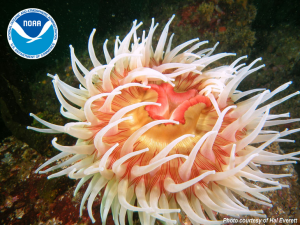
Wednesday, July 8, 2020, at 10 am PT/1 pm ET
Swimming in Dirty Water - Pollution and Fish Health with Cathy Laetz, NOAA's Northwest Fisheries Science Center in Seattle, WA

Resources to access at home:
» National Institute of Environmental Health Sciences Kids Health website. Explore this page to find games, activities, songs, coloring pages, and more!
» PBS Learning Media: Pollution and Wast - Find lots of interesting Public Television videos on scientific and environmental topics.
» TED-Ed - View short video lessons aimed at educators and students. Many are collaborations between educators and animators. There are a wide range of science topics.
» Environmental Protection Agency (EPA) - educational resources for students, parents, and teachers.
Monday, July 13, 2020, at 10 am PT/1 pm ET
The Wonderful World of Plankton: the Tiny Animals of the Sea with Colleen Harpold and Alison Deary, NOAA's Alaska Fisheries Science Center in Seattle, WA

Resources to access at home:
» NOAA Ecosystems & Fisheries-Oceanography Coordinated Investigations (EcoFOCI) Website. Find out more about the research and data that is collected.
» Plankton Portal. This website gives you an opportunity to do some citizen science and ID plankton!
Wednesday, July 15, 2020, at 10 am PT/1 pm ET
Demystifying Science through Video with Filmmaker Paul Hillman, NOAA Fisheries Communications Office in Seattle, WA

Resources to access at home:
» NOAA Fisheries Video Gallery Watch some of these amazing videos on topics ranging from aquaculture, coral conservation, sustainable fisheries, and more.
» NOAA Fisheries YouTube Channel. View a wide variety of videos on topics ranging from protected species, species in the spotlight, and more.
Wednesday, September 30, 2020, at 4 pm ET
Carbon's Journey and Our Warming Planet with Frank Niepold and Tom Di Liberto, NOAA's Climate Program Office in Silver Spring, MD

Resources to access at home:
» Why is Carbon Important: This NASA site is aimed at kids and does a nice job of explaining what carbon is as well as its importance.
» The Incredible Carbon Journey: Play the Carbon Journey Game with your class or a group at home (Use the blue "Jump to this Activity" button on the website linked to here).
» MIT's Greenhouse Gas Simulator: This simple animated simulation of the global carbon system is great for helping kids explore the relationship between carbon emissions and atmospheric carbon dioxide. (Teacher link)
» NASA Climate Kids Offset Game: As you play this online game you earn money so you can buy "upgrades" to your carbon sources and sinks. Meanwhile, carbon dioxide molecules are escaping into the atmosphere.
» Background articles from climate.gov for parents or teachers:
Which emits more carbon dioxide: volcanoes or human activities?
Carbon dioxide: earth's hottest topic is just warming up
Climate change: atmospheric carbon dioxide
Tuesday, October 6, 2020, at 3 pm ET/11 am AKT
Baby Beluga in the Shallow Gray Sea - looking for newborn whales with drones in Cook Inlet, Alaska with Kim Goetz, NOAA Alaska Fisheries Science Center in Seattle, WA
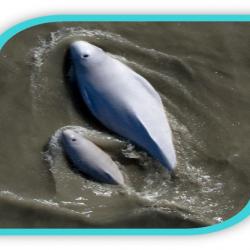
The webinar was also be live-streamed on Facebook Live on the NOAA Fisheries Alaska Facebook page - @NOAAFisheriesAK
Resources to access at home:
» Studying Endangered Cook Inlet Belugas in Alaska
» Beluga Whale Hexacopter Survey - Science Blog
» Belugas Count! video
» Species in the Spotlight: Cook Inlet Beluga Whale
» Plumbing the Deep: Using Sound Waves to See
Wednesday, October 7, 2020, at 4 pm ET
Up, Up, and Away - Flying High with NWS Weather Balloons with Jeff Orrock, NOAA's National Weather Service in Wakefield, VA

Resources to access at home:
» National Weather Service Kids Corner: Weather balloons page including a video of a weather balloon launch.
» National Weather Service Education Page: Weather science, games, weather safety, and careers for kids, parents, and teachers.
» UCAR Center for Science Education: Explore the atmosphere by launching virtual weather balloons.
» UCAR Center for Science Education: Learn more about weather balloons.
» NOAA's JetStream - An Online School for Weather: This has downloadable posters about clouds and weather, information about the atmosphere, global weather, and many more topics.
» NOAA's SciJinks - It's All About Weather: This is for educators and students. You'll find games, information, classroom activities, videos, and more.
Tuesday, October 13, 2020, at 3 pm ET/11 am AKT
The crab-tivating life of crustaceans: diving into Alaskan snow crab and red king crab biology with Erin Fedewa and Leah Zacher, NOAA Fisheries Alaska Fisheries Science Center's Kodiak Laboratory in Kodiak, AK

The webinar will also be live-streamed on Facebook Live on the NOAA Fisheries Alaska Facebook page - @NOAAFisheriesAK
Resources to access at home:
» Red king crab life stages - a short course
» Crab education pages
» NOAA Fisheries - Red King Crab
» NOAA Fisheries - Snow Crab
» New Studies Raise Questions About Crabs’ Adaptability
» Dutch Harbor Snow and Tanner Crab Growth Study - a science blog
Wednesday, October 14, 2020, at 4 pm ET
Dolphin Tales - Stories and facts about dolphins and marine mammal strandings in the Southeast US with Blair Mase, NOAA Fisheries Southeast Fisheries Science Center in Miami, FL
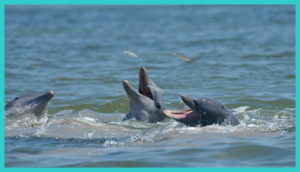
Resources to access at home:
» Marine Mammal Health and Stranding Response Program: Learn more about the volunteer stranding and entanglement networks and find your regional program.
» Report a Stranded or Injured Marine Animal
» FAQs about why it is illegal to feed or harass a marine mammal in the wild.
» Video used during the talk: Dolphin Sounds - Sounds of Nature
» NOAA National Marine Sanctuaries Outreach Corner: Marine mammal and sea turtle viewing guidelines, see and id smartphone apps, fact sheets and more.
» NOAA Marine Debris Activities and Curricula: Activity books, bookmarks, magnets, and more.
Tuesday, October 20, 2020, at 3 pm ET/11 am AKT
Exploring the Ocean Seafloor: Underwater Volcanoes and their Habitats with Colleen Hoffman, Cooperative Institute for Climate, Ocean, and Ecosystem Studies and NOAA Pacific Marine Environmental Lab in Seattle, WA
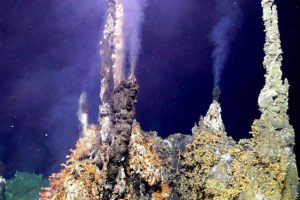
» View recorded webinar (subtitles available in Spanish and English)
The webinar will also be live-streamed on Facebook Live on the NOAA Fisheries Alaska Facebook page - @NOAAFisheriesAK
Resources to access at home:
» Videos used in the talk: Volcanic eruptions on the seafloor, Life at a Hydrothermal Vent, and What it is like to go down in HOV Alvin
Videos:
» Demo for Oreo plate tectonics
» Last 40 years of hydrothermal vent explorations (video showing all the different types of systems)
» C-DEBI deep-sea lesson plans
» NOAA Ocean Today Every Full Moon: Deep Sea Dive Collection
» NOAA Ocean Explorer: Hunting for Alien Life at the Bottom of the Arctic Ocean
» NOAA Ocean Explorer: Hydrothermal Vents: 2016 Deepwater Exploration of the Marianas
» NOAA Ocean Explorer: Education Therme: Vents and Volcanoes lesson plans
» HACON - Hot Vents in an Ice-Covered Ocean
Books:
» Exploring the Deep, Dark Sea by Gail Gibbons.
» Alien Deep: Revealing the Mysterious Living World at the Bottom of the Ocean (National Geographic Kids) by Bradley Hague.
» Discovering the Deep by Jeffrey A. Karson, Deborah S. Kelley, Daniel J. Fornari, Michael R, Perfit, and Timothy M. Shank.
Wednesday, October 21, 2020, at 4 pm ET
Fire Weather at an Incident with Kari Fleegel, NOAA's National Weather Service in Aberdeen, SD
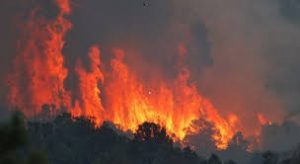
» View recorded webinar (subtitles available in Spanish and English)
Resources to access at home:
» National Weather Service (NWS) Wildfire safety: This has safety and preparedness information.
» NWS wildfire safety tips video: This is a short, 1 1/2 minute video
» NWS Seasonal Safety Campaign (which includes a few wildfire safety infographics #1 and #2): Information on how to prepare for hazardous weather year-round
» Ready.gov web resource: Find information on preparing, staying safe, and returning home after the fire.
» Midwestern Regional Climate Center with some specialized information for wildfires in the Midwestern US
» Smokey Bear for Kids: Star with Smokey in a story, play a game to learn how to spot fire dangers while camping, and design a coloring page with Smokey.
» Smokey Bear for Educators: There are K-2 and middle school activities and materials.
Tuesday, October 27, 2020, at 3 pm ET/11 am AKT
Ping! - Using sound to map Alaska's seafloor with Jessica Murphy and LTjg Michelle Levano, NOAA's Office of Coast Survey in Seattle, WA
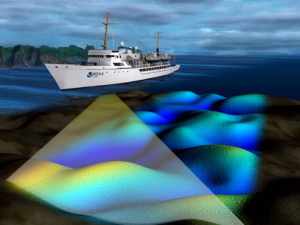
» View recorded webinar (subtitles available in Spanish and English)
The webinar will also be live-streamed on Facebook Live on the NOAA Fisheries Alaska Facebook page - @NOAAFisheriesAK
Resources to access at home:
» NOAA’s Office of Coast Survey Educational Activities: Learn more about the seafloor and nautical charting through posters, interactive activities (check out the digital terrain activity!), and hands-on activities you can do at home.
» Alaska Surveys Storymap
» Finding Nautical Charts
» Travel the Seas Video
» Plumbing the Deep: Using Sound Waves to See
Wednesday, October 28, 2020, at 4 pm ET
Deep and Creepy: Things that go Bump in the Deep Sea with Kasey Cantwell, NOAA's Office of Ocean Exploration and Research in Silver Spring, MD
A special Halloween edition of NOAA Live! - "Creatures of the Deep" will explore the fascinatingly creepy creatures of the deep ocean. Join us to learn more about the unique animals that exist in the deep sea and the different adaptations that make it possible to live in this extreme environment!
» View recorded webinar (subtitles available in Spanish and English)
» NOAA Ocean Exploration and Research Education Page: This includes lesson plans, multimedia interactive activities, career information, and more
» NOAA Exploring Deep-Ocean Art: Coloring book and coloring pages.
» Bioluminescence, Deep-sea Corals, and Cold Seeps, : Videos, past expeditions, lesson plans, and more.
» Benthic Deepwater Animal Identification Guide: Explore this amazing collection of images from the Deep Discoverer remotely operated vehicle.
» NOAA Build an Underwater Robot: This is a guide to making a simple version of an underwater remotely operated vehicle.
» NOAA Ocean Today/Creep into the Deep: There are some great videos on how animals in the deep sea have evolved to breed, feed, and survive in one of the harshest realms of the ocean.
» Zooplankton in the Deep Sea: This Hawaii Sea Grant video is a great introduction to zooplankton in the deep ocean.
» Ocean Exploration Facts
» Octonauts Corner: coloring pages, video tour of Okeanos for kids, and deep sea creature chart
» Dive and Discover with the Woods Hole Oceanographic Institution: Hydrothermal vents animals
» Whale Times, Inc - Creep into the Deep, Journey into Midnight Cruise: There are some great coloring pages
» Ocean Explorer Make your own Deep Sea Vent activity for grades 5-6.
Tuesday, November 3, 2020, at 4 pm ET - NO WEBINAR (VOTING DAY)
Wednesday, November 4, 2020, at 4 pm ET
Oysters: Nature's Vacuum Cleaners with Harriet Booth, NOAA's Woods Hole Sea Grant and Cape Cod Cooperative Extension in Barnstable, MA
Have you ever seen or eaten an oyster? How is it different from a clam? Did you know they can filter 1.3 gallons of water per hour and are often put in bays and salt water ponds to clean up the water? Do you know how they spawn (reproduce)? Who eats them (hint -we do) and what research do we do to support shellfish farmers or wild harvesters? Learn all this and more during this NOAA Live! webinar. (Live ASL interpretation)
» View recorded webinar (subtitles available in Spanish and English)
Resources to access at home:
» Oyster Life Cycle: This is a short 2-minute video that walks you through the oyster life cycle.
» NOAA K-12 Science Module - "Oysters in the Chesapeake Bay": This has curriculum for elementary, middle school, and high school grade lessons. This is relevant regardless of where you live.
» Oyster Reef Habitat - This NOAA Fisheries website has valuable information about oyster reefs.
» Marine Biological Laboratory Demonstrates How Oysters Filter Water: This is a short 2 minute that shows oysters filtering algae out of the water.
» Cape Cod Cooperative Extension Publications and Resources: Publications include "Tips for fresh and tasty shellfish", "Easting shellfish as part of a healthy diet", "Safe shellfish for recreational harvesters", and more.
» Octonauts - Learn about shellfish: In this video Octonauts are learning all about shellfish! Lobsters, shrimp, crabs, and more.
Tuesday, November 10, 2020, at 3 pm ET/11 am AKT
Not Your Friendly Neighborhood Wave: Staying Safe from Tsunamis in Alaska with Dr. Summer Ohlendorf, NOAA's National Weather Service Tsunami Warning Center in Palmer, AK
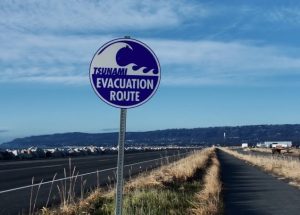
» View recorded webinar (subtitles available in Spanish and English)
The webinar will also be live-streamed on Facebook Live on the NOAA Fisheries Alaska Facebook page - @NOAAFisheriesAK
Resources to access at home:
» NOAA Educational Tsunami Resources
» Alaska tsunami evacuation maps and more!
» Interactive tsunami inundation/flooding maps
» Alaska geohazard educational resources - Earthscope Alaska Native Geoscience Learning Experience (ANGLE)
» NOAA Mitigates the Impact of Killer Waves – Storymap
Wednesday, November 11, 2020, at 4 pm ET - NO WEBINAR (VETERANS DAY)
Tuesday, November 17, 2020, at 3 pm ET/11 am AKT
What's in the Kelp Forest? Exploring the Shore and Diving Underwater in Kachemak Bay, Alaska with Kris Holderied, NOAA Kasitsna Bay Laboratory, NOAA Ocean Service and Katie Gavenus, Center for Alaskan Coastal Studies
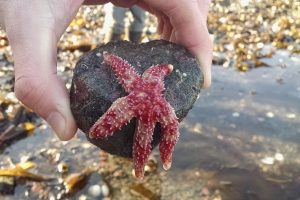
» View recorded webinar (subtitles available in Spanish and English)
The webinar will also be live-streamed on Facebook Live on the NOAA Fisheries Alaska Facebook page - @NOAAFisheriesAK
Resources to access at home:
» NOAA Ocean Service: What is the intertidal zone?
» Alaska Department of Fish and Game: Tidepooling in Alaska including an overview, tidepool etiquette, etc.
» Center for Alaskan Coastal Studies Educator Resources
» Video: Science and Stewardship: Keys to Restoring Kachemak Bay
» Kasitsna Bay Lab Dive Class “Movie Trailer”
» Activities: Life in the Intertidal Zone
Wednesday, November 18, 2020, at 4 pm ET
Science on the Half Shell: Behind the Scenes at the Milford Fisheries Laboratory with Mark Dixon and Gillian Phillips, NOAA Northeast Fisheries Science Center in Milford, CT
Have you ever wondered what kind of science is conducted at a fisheries laboratory? Meet NOAA scientists from the Northeast Fisheries Science Center's Laboratory in Milford, CT, who study shellfish and investigate questions that help shellfish growers around the world. You will learn about what oysters eat, how they are helping make a cleaner Long Island Sound, and see, through real fish surveillance, how shellfish farms can become habitat for other species. (Live ASL interpretation)
» View recorded webinar (subtitles available in Spanish and English)
Resources to access at home:
» Current research at Milford
» Fish printing is usually a popular station: Read this article on the educational uses of gyotaku or fish printing. Try it at home after watching this video (for older kids) or this video (for younger kids). Remember - you can use a rubber fish and even print onto clothing.
Tuesday, December 1, 2020, at 3 pm ET/11 am AKT
Alaska Sea Ice, Ice, Baby with Michael Lawson, NOAA's National Weather Service in Anchorage, AK
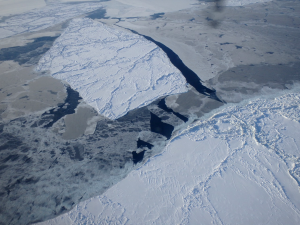
» View recorded webinar (subtitles available in Spanish and English)
The webinar will also be live-streamed on Facebook Live on the NOAA Fisheries Alaska Facebook page - @NOAAFisheriesAK
Resources to access at home:
» NOAA National Snow & Ice Data Center
» Ten Signs of a Warming World - Arctic Sea Ice
» Melting Ice Science Experiment
» Whither Arctic Sea Ice? - grades 7-12
» Sea Ice Index - Sea Ice Animation Tool
» Citizen Science: CoCoRaHS - Community Collaborative Rain, Hail & Snow Network
Wednesday, December 2, 2020, at 4 pm ET
Saving Corals: A Day in the Life of a Coral Reef Scientist with Derek Manzello, NOAA's Atlantic Oceanographic and Meteorological Laboratory in Miami, FL
The mission of NOAA’s National Coral Reef Monitoring Program is to provide information to help improve and sustain coral reef health throughout the world. Meet Derek Manzello, a NOAA coral reef scientist, who dons scuba gear when heading to his office - the world's most beautiful ecosystem and a place that most people only see when they are on vacation. Look at the world through his eyes (or scuba mask) as he shows us the tools they use, shares his favorite fieldwork experience and helps us understand the challenges coral reefs face today. (Live ASL interpretation)
» View recorded webinar (subtitles available in Spanish and English)
Resources to access at home:
» NOAA Coral Reef Conservation Program Education Page
» NOAA National Ocean Service Corals Tutorial
» Interactive Reef Virtual Dive - Explore this virtual reef and learn more about corals
» Bleached Reef Virtual Dive - In early 2015, coral bleaching started in the Airport Pool on Tutuila. This image shows the staghorn corals in the midst of the severe bleaching event.
» How do corals build their reefs? Visit this California Academy of Sciences Page to learn more. (Dana shows the video from this page during the webinar)
» National Marine Sanctuaries Virtual Dives of different reefs
» NOAA Ocean Today Coral Comeback Videos: There are 9 short videos- Rainforests of the sea, the coral and the algae, corals under threat, what can we do, and more.
Tuesday, December 8, 2020, at 3 pm ET/11 am AKT
Drones, Scat, and the Joys of Marine Mammal Fieldwork in Alaska with Katie Sweeney, NOAA Fisheries Alaska Fisheries Science Center in Seattle, WA
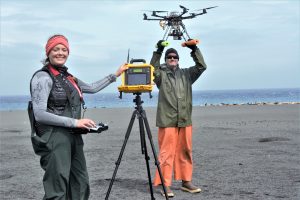
» View recorded webinar (subtitles available in Spanish and English)
The webinar will also be live-streamed on Facebook Live on the NOAA Fisheries Alaska Facebook page - @NOAAFisheriesAK
Resources to access at home:
» Fur seals on Bogoslof Island - 2019 science blog
» Investigating Steller Sea Lion Declines on Remote Aleutian Islands - 2016 science blog
» Investigating Steller Sea Lion Populations - video
» Steller Sea Lion Aerial Survey - 2017 science blog
» From 2017 and 2018: Thousands of People Help Scientists with Research on Endangered Steller Sea Lion, Stellar Progress on Steller Watch
Wednesday, December 9, 2020, at 4 pm ET
Seeing the World Through a Sea Turtle's Eyes with Samir Patel, NOAA Fisheries Northeast Fisheries Science Center in Woods Hole, MA
Sea turtles are considered living dinosaurs in that they have remained relatively unchanged for over 100 million years and yet continue to thrive in our world's ocean. How are turtles able to do this? We use several camera techniques to film sea turtles as they swim through the ocean diving, foraging, and avoiding predators to understand how they are able to survive and thrive in their preferred habitats. (Live ASL interpretation)
» View recorded webinar (subtitles available in Spanish and English)
Resources to access at home:
» Sea turtle stranding network: You can find your region and the number to call if you see a stranded sea turtle.
» NOAA Education sea turtle page: Find information about the six species of sea turtles found in U.S. waters, stories, background material, videos, and classroom lesson plans and activities.
» Sea Turtle identification guide for the Northeast US
» National Marine Life Center in MA: Their virtual discovery zone has a sea turtle puppet craft, live patient updates on their sea turtles currently in rehab, and many videos.
» NOAA's Activity Book on sea turtles: This activity booklet is aimed at grades 3-5.
Tuesday, December 15, 2020, at 3 pm ET/11 am AKT
Youth Programs on St. Paul Island, Alaska with Lauren Divine and Veronica Padula, Aleut Community of St. Paul Island Tribal Government on St. Paul Island, AK
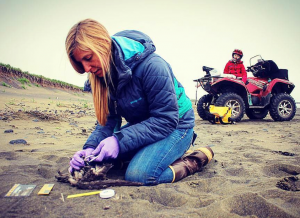
» View recorded webinar (subtitles available in Spanish and English)
The webinar will also be live-streamed on Facebook Live on the NOAA Fisheries Alaska Facebook page - @NOAAFisheriesAK
Wednesday, December 16, 2020, at 4 pm ET
Abalone: Gardeners of the Kelp Forest with David Witting, NOAA's Restoration Center in Long Beach, CA
» View recorded webinar (subtitles available in Spanish and English)
Resources to access at home:
» Aquarium of the Pacific kids song/video: "I Love Abalone"
» NOAA Fisheries Feature Story: "Divers Release Endangered Abalone into the Wild for First Time, Boosting Odds of Recovery "
» NOAA Fisheries Feature Story: "White Abalone: Why You Should Care About This Critter"
» NOAA white abalone "Species in the Spotlight" video
Wednesday, January 6, 2021, at 4 pm ET
Whale and Seek: The Underwater Lives of Whales with Dave Wiley, NOAA Stellwagen Bank National Marine Sanctuary in Scituate, MA
How do you know what whales do in the wild? They are too big for an aquarium and disappear from view at every dive. New technologies let scientists attach body movement and acoustic (sound) or video recording tags to whales to watch and listen as they go about their underwater lives. The results surprised even the scientists that had spent their whole lives studying the animals! (Live ASL interpretation)
» View recorded webinar (subtitles available in Spanish and English)
Resources to access at home:
Activities
» NOAA National Marine Sanctuaries (NMS) Humpback Whale Migration Game (online)
» New Bedford Whaling Museum Whale Activities
» Hawaiian Islands Humpback Whale National Marine Sanctuary Activity Book you can print out. This includes a whale identification activity, word search, connect the dots, and more.
Videos and Background
» Dive in and find the National Marine Sanctuary closest to you
» NOAA Oceans Today 4-minute video and short story: Ocean as a Lab: Whale Tagging in Antarctica
» NOAA NMS 45 second video: Tagging Humpback Whales in Stellwagen Bank National Marine Sanctuary
» DE Sea Grant 15 Second Science Videos: All about whales with Bob Rocha, New Bedford Whaling Museum
» NOAA NMS: Dive into Stellwagen Bank National Marine Sanctuary with these short videos on topics such as humpback whales, sand lance, Christmas bird count, gray seals, and more!
» NOAA NMS story: High-Tech Whale Tagging featuring Dave Wiley
» NOAA actions taken to reduce ship strikes
Tuesday, January 12, 2021, at 3 pm ET/11 am AKT
Talking Trash: Marine Debris Research in Alaska with Peter Murphy, NOAA's Marine Debris Program in Seattle, WA
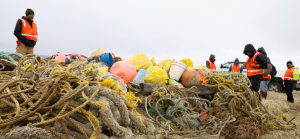
» View recorded webinar (subtitles available in Spanish and English)
The webinar will also be live-streamed on Facebook Live on the NOAA Fisheries Alaska Facebook page - @NOAAFisheriesAK
Resources to access at home:
» NOAA Marine Debris Program games and activities for kids of all ages + posters and fact sheets
» NOAA Trash Talk - short videos on marine debris and what you can do.
» Marine Debris in Alaska
» St. Paul Island, Alaska Marine Debris Cleanup 2019
» Partnering with Native Communities to Take On Marine Debris
» NOAA Marine Debris Program in Your Region - Find your regional coordinator as well as state or region-specific information on current marine debris projects and activities.
» NOAA Ocean Today Trash Talk Videos: There are 11 short videos- What is marine debris, where does marine debris come from, impacts of marine debris, and more.
Wednesday, January 13, 2021, at 4 pm ET
Bringing Weather Forecasting Down to Earth with Tim Walsh, NOAA's Satellite Service in Silver Spring, MD
Did you know that 95% of the data used in weather forecasting models comes from satellites? NOAA’s Satellite Service operates the Nation’s weather satellites around the clock, 365 days a year. The next generation of these satellites are being built and prepared for launch by NOAA and NASA. With information from our satellites, airlines can get back to the skies more quickly after foggy conditions, farmers learn when and how to plant crops for better harvests, and ships can navigate a course around dangerous seas or ice. And you know whether to bring an umbrella or sunscreen for your day outside! Join engineer Tim Walsh as he explains what makes the spacecraft orbits for earth-observing satellites special, what it takes to build and launch a spacecraft, and what the future might bring! (Live ASL interpretation)
» View recorded webinar (subtitles available in Spanish and English)
Resources to access at home:
Meet JPSS, a pair of Earth-orbiting satellites that give scientists data to predict the weather and climate! JPSS measures water, clouds, wind, temperature and air pressure – which all affect our daily weather. Using JPSS data, scientists can predict and provide warnings for hurricanes, tornadoes and blizzards. JPSS also measures droughts, forest fires, air and water quality, and the health of our ozone layer. There are many ways you can find JPSS in Your Community!
Activities and Resources
» Meet JPSS Comic
» JPSS Coloring Page
» JPSS Detects Greenhouse Gases and Aerosols: Build a Molecule Activity
» JPSS Understanding Infrared Light Activity
» JPSS How to Measure Snow Activity
Videos
» NOAA-20 satellite orbit with Suomi NPP and JPSS-2: See how a polar orbit works.
» JPSS Proving Grounds: Watch and learn about the human impact of weather data.
» 5 Things that Changed Weather Forecasting Forever
» Our Eyes in the Sky: Watch how satellites have improved hurricane forecasting
» Satellite and Weather Videos for Kids: https://goes-r.gov/multimedia/
» Videos used during the webinar:
Polar Orbit Video
NOAA-20 Satellite Launch and Stages Video
Small Satellite Video
Tuesday, January 19, 2021, at 3 pm ET/11 am AKT
Some Like It Hot, Some Like It Cold: Monitoring Fish and Ecosystems With Bottom Trawl Surveys in Alaska with Sean Rohan from NOAA Fisheries Alaska Fisheries Science Center in Seattle, WA
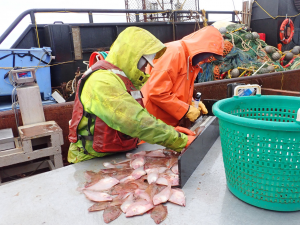
» View recorded webinar (subtitles available in Spanish and English)
The webinar will also be live-streamed on Facebook Live on the NOAA Fisheries Alaska Facebook page - @NOAAFisheriesAK
Resources to access at home:
» Fishing Gear: Bottom Trawls
» Alaska Fisheries Science Center Fisheries Research Surveys
» Eastern Bering Sea Shelf Survey - 2017 science blog
» Fish Fetch - fish population estimation activity
Wednesday, January 20, 2021, at 4 pm ET
It Takes a Village to Save the Hawaiian Monk Seal with Stacie Robinson, NOAA Fisheries Pacific Islands Fisheries Science Center in Honolulu, HI and Wendy Marks, the Marine Mammal Center in Kona, HI
Did you know that Hawaiʻi is home to the world's only tropical seal - the Hawaiian monk seal? You'll learn about these highly endangered marine mammals, where they live, and the conservation efforts to protect them. We'll follow monk seals on an underwater foraging adventure using cameras worn by the seals! You can see the methods the seals use to explore their environment and search for food. We will also highlight the partnership between NOAA and The Marine Mammal Centerʻs Ke Kai Ola Hospital. Located in Kona, on Hawaiʻiʻs Big Island, Ke Kai Ola is a place where sick and injured Hawaiian monk seals are brought for treatment and rehabilitation. We will be sharing some seal patient stories and how we help seals both in the hospital and out on the beaches. (Live ASL interpretation)
» View recorded webinar (subtitles available in Spanish and English)
Resources to access at home:
» Marine animal stranding network: You can find your region and the number to call if you see a marine animal.
» NOAAʻs Hawaiian Monk Seal Coloring Book
» NOAA Fisheries Hawaiian Monk Seal Species Page
» The Marine Mammal Center - Online Learning Resources
» Aloha ʻĀina Activity about littering and marine debris
» Mālama i nā ʻĪlioholoikauaua about sustainability
» Marine Mammal Monday: Saving Species recording and activity
» Some Ocean Optimism Ep. 6: Hawaiian Monk Seals, 6-minute video
Tuesday, January 26, 2021, at 4 pm ET/12 am AKT
Alaska Marine Science Symposium in Anchorage: Cutting-Edge Science Connecting with Education with Elizabeth Siddon, NOAA Fisheries Alaska Fisheries Science Center in Juneau, AK, and Mark Van Arsdale, Eagle River High School in Eagle River, AK

» View recorded webinar (subtitles available in Spanish and English)
The webinar will also be live-streamed on Facebook Live on the NOAA Fisheries Alaska Facebook page - @NOAAFisheriesAK
Resources to access at home:
» Alaska Marine Science Symposium
» North Pacific Research Board
» SouthEast Exchange
» Meet Elizabeth Siddon, one of 2019's PECASE WInners
» Mark Van Arsdale's Teacher at Sea Blog from 2018
Wednesday, January 27, 4 pm ET
Dambusters at Work: Restoring Habitat for Migratory Fish with Eric Hutchins, NOAA Restoration Center in Gloucester, MA
Soon after the Pilgrims landed at Plymouth Rock they began to build dams on Town Brook in Plymouth, Massachusetts. Every dam built impacted the migratory pathway of American eel and river herring which need to reach fresh water streams to complete their lifecycle. This talk will describe efforts by the Town of Plymouth and NOAA to remove or modify dams on Town Brook to restore habitats for migratory fish....and wait until you hear what they found when they tore down those dams! (Live ASL interpretation)
» View recorded webinar (subtitles available in Spanish and English)
Resources to access at home:
» Meet Eric Hutchins, Habitat Restoration Biologist Feature Story
» U.S. Fish and Wildlife: Teaching kids about fish migration. There is a fun lesson, "Designing fish-friendly culverts (and bridges)" lesson for grades 5-8.
» U.S. Fish and Wildlife: Environmental education resources for teachers, parents, and kids. Activities range from the "ABCs of fishing" coloring book, word searches, migration station, and more.
» NOAA Fisheries article, "You can help scientists count migrating river herring - virtually"
» U.S. Fish and Wildlife: Teaching kids about fish migration. There is a fun lesson, "Designing fish-friendly culverts (and bridges)" lesson for grades 5-8.
» U.S. Fish and Wildlife: Environmental education resources for teachers, parents, and kids. Activities range from the "ABCs of fishing" coloring book, word searches, migration station, and more.
» Help count the river herring:
--Mystic River, Massachusetts Herring Counter, https://www.mysticherring.org/video#/
--Town Brook, Plymouth Massachusetts Herring Counter https://www.plymouthriverherring.org/
» Watch Live Fish Cameras:
--Herring Creek on Martha’s Vineyard https://wampanoagtribe-nsn.gov/naturalresourcedepartment
--Town Brook, Plymouth Massachusetts Herring Counter https://www.plymouthriverherring.org/
» Other relevant NOAA Live! Webinars: Swimming Upstream with River Herring OR Leaping for Atlantic Salmon: Protecting endangered species
Tuesday, February 2, 3 pm ET/11 am AKT
Salmon in the Winter: Anadromous fish under ice with Coowe Walker and Jacob Argueta, NOAA's Kachemak Bay National Estuarine Research Reserve in Kachemak Bay, AK
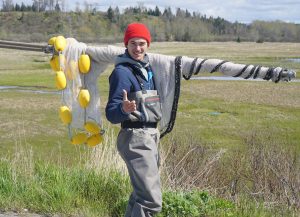
» View recorded webinar (subtitles available in Spanish and English)
The webinar will also be live-streamed on Facebook Live on the NOAA Fisheries Alaska Facebook page - @NOAAFisheriesAK
Resources to access at home:
» Anchor River on Ice Video
» Overwintering juvenile coho salmon study-Alaska Sustainable Salmon Fund
» Kachemak Bay NERR - NOAA Office of Coastal Management
» Kachemak Bay NERR - Education and Outreach
» Salmon: A Student Journal - activity book
» An Incredible Journey - curriculum about issues affecting salmon and how to become a salmon steward
Wednesday, February 3, 4 pm ET
Designed to Survive: Prepare Your Home to Withstand Storms with Kanesa Duncan Seraphin, NOAA's Hawai'i Sea Grant, Honolulu, HI
Large storms can bring destructive winds, rain, flooding, and storm surge. What materials or designs help your house survive a storm? How can homes be built, or modified, to keep people dry and safe during strong storms? Join University of Hawaiʻi Sea Grant educator, scientist, and TV producer, Kanesa Duncan Seraphin, in a hands-on activity to build a cardboard house and engineer storm-resistant features. We’ll talk about how to be prepared for a storm, how engineers design buildings to withstand major destructive forces like earthquakes and tsunamis, and weʻll explore some futuristic architectural design ideas for coastal communities. (Live ASL interpretation)
» View recorded webinar (subtitles available in Spanish and English)
Resources to access at home:
» Designs that Survive Storms Activity: This activity has kids building a carboard house and engineering storm-resistant features. It includes a cardboard house template, a make-it-yourself playdough recipe, and more.
» NOAA Ocean Today video on storm surge (~2 1/2 minutes)
» Traditional Ways of Knowing: Hurricanes article.
» Background information on Natural Hazards (geared toward adult activity facilitators and aligned to OLP/NGSS)
» Sea Grant Homeowners Handbook to Prepare for Natural Hazards: This includes information on how to prepare your house for a storm and create a family emergency and evacuation plan. Find your state: HI, MA, DE, FL, GA, LA, MI/AL, TX, VA
» Other relevant NOAA Live! Webinars: Getting Prepared for Hurricane Season OR Talking Tornadoes with a Storm Researcher OR Minutes Matter: Nature's Warning Signs for Tsunami
» Related "Voice of the Sea" video episodes hosted by Kanesa Seraphin:
Designing Future Coastal Communities
Engineering Tsunami Resilience
Hazard and Hurricane Preparedness
Tuesday, February 9, 3 pm ET/11 am AKT
Let's Talk about Fish Food: Zooplankton in the Eastern Bering Sea with Deana Crouser, NOAA Fisheries Alaska Fisheries Science Center in Seattle, AK

» View recorded webinar (subtitles available in Spanish and English)
The webinar will also be live-streamed on Facebook Live on the NOAA Fisheries Alaska Facebook page - @NOAAFisheriesAK
Resources to access at home:
» NOAA Ecosystems & Fisheries-Oceanography Coordinated Investigations (EcoFOCI) Website. Find out more about the research and data that is collected.
» Plankton Portal. This website gives you an opportunity to do some citizen science and ID plankton!
» Climate Drives Change in an Arctic Food Web
» Lawrence Hall of Science - Ocean Currents Animation - see how ocean circulation changes when air temperature and salinity change
» Aquatic Food Webs - NOAA Education Resource Collection - lesson plans, activities, and more!
Wednesday, February 10, 4 pm ET
It’s Not Easy Being Shelled: the Ocean Acidification Blues with Meg Chadsey, NOAA's Washington Sea Grant and the NOAA Pacific Marine Environmental Lab in Seattle, WA
Excess carbon dioxide (CO2) isn’t just warming the planet; it’s also reacting with seawater and making the oceans more corrosive—a process known as ocean acidification. This slight increase in acidity doesn’t change the way the ocean looks or feels to us—but it’s a big deal for marine species with hard parts made of calcium carbonate, like pteropods, whose delicate shells begin to dissolve when exposed to acidified seawater. Meg Chadsey will demonstrate how ocean acidification is stressing her favorite local shellfish species—oysters—and explain why some shellfish farmers are turning to kelp for help. (Live ASL interpretation)
» View recorded webinar (subtitles available in Spanish and English)
Resources to access at home:
» Lego Calcification Challenge Activity
» Red Cabbage Ocean Acidification in a Cup Activity
» Rosemary Mosco's Ocean Acidification Cartoon: pretty much everything you need to know about OA in 8 panels
» What is Ocean Acidification: A Crash Course - a 2-minute animated video, drawn by Sherman’s Lagoon cartoonist Jim Toomey
» Washington Sea Grant Ocean Acidification webpage
» The Power of Kelp: a 6-minute video about the benefits of kelp farming
» Washington Sea Grant’s Kelp Aquaculture webpage: a deep dive into the many uses for farmed kelp
» Tracking Ocean Acidification in Puerto Rico Video: this 8-minute video is in Spanish with an English subtitle option
» Ocean Acidification and Clownfish: This is a ~5-minute video
Tuesday, February 16, 3 pm ET/11 am AKT
Let it Snow, Let it Snow, Let it Snow...but How Much? with Dr. Jessica Cherry, NOAA’s National Weather Service’s Alaska-Pacific River Forecast Center in Anchorage, AK
it Snow, Let it Snow, Let it Snow...but How Much? with Dr. Jessica Cherry, NOAA’s National Weather Service’s Alaska-Pacific River Forecast Center in Anchorage, AK

» View recorded webinar (coming soon - subtitles available in Spanish and English)
The webinar will also be live-streamed on Facebook Live on the NOAA Fisheries Alaska Facebook page - @NOAAFisheriesAK
Resources to access at home:
» CoCoRaHS - Community Collaborative Rain, Hail & Snow Network
» Citizen Science: Local Environmental Observer (LEO) Network
» The changing planet, a changing Arctic: NOAA news story
» Weather-Ready Nation: This site is about readying your community for extreme weather, water, and climate events
» National Weather Service Education Page
» SciJinks - NOAA and NASA weather education website with lots of activities (precipitation simulator, grow snow crystals)
» NOAA's National Severe Storms Laboratory - Learning Resources - Severe Weather 101, lesson resources, student activities
» NOAA Education Resource Collection - Weather and Atmosphere data resources
Tuesday, February 23, 3 pm ET/11 am AKT
Lose the loop: How did entangled Steller sea lions lead to Alaska’s first Ocean Guardian schools? with Kim Raum-Suryan, NOAA Fisheries' Alaska Region in Juneau, AK
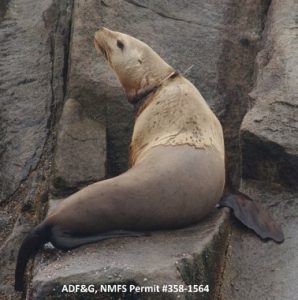
» View recorded webinar (coming soon - subtitles available in Spanish and English)
The webinar will also be live-streamed on Facebook Live on the NOAA Fisheries Alaska Facebook page - @NOAAFisheriesAK
Resources to access at home:
» Marine Mammal Stranding Program (Stranding Hotline: 877-925-7773)
» NOAA article: "Pinniped entanglement in marine debris". (pinnipeds are seals, sea lions, and fur seals)
» AK Department of Fish and Game article: "Tangled sea lions get help, biologist team up for capture and aid"
» Entanglement in Marine Debris - Alaska Department of Fish and Game
» Keep the Sea Entanglement Free! - brochure
» Learn how to become an Ocean Guardian School
» Juneau Empire article: "Juneau schools launch ocean guardian program to combat marine mess."
» Juneau Empire article: "Planet or plastic? Students do their part to protect oceans."
Tuesday, March 2, 3 pm ET/11 am AKT
That's the Seal-iest Thing I've Heard: Studying Ice Seals in Alaska with Erin Moreland, Cynthia Christman, and Heather Ziel, from NOAA Fisheries Alaska Fisheries Science Center in Seattle, WA
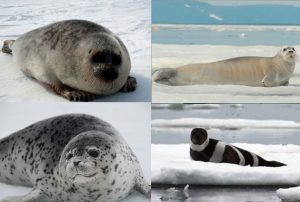
» View recorded webinar (coming soon - subtitles available in Spanish and English)
The webinar will also be live-streamed on Facebook Live on the NOAA Fisheries Alaska Facebook page - @NOAAFisheriesAK
Resources to access at home:
» Ice Seal Research in Alaska
» Protected Threatened Ice Seals - video
» Developing Artificial Intelligence to Find Ice Seals and Polar Bears from the Sky
» Ice-Associated Seal Ecology Research Survey in the Bering Sea - science field blog
» Joint U.S.-Russian Aerial Surveys for Ice-Associated Seals in the Bering Sea
Wednesday, March 3, 4 pm ET
 March 2021 Open House Series
March 2021 Open House Series
150 Years and Counting: Studying Fish, Fisheries and More at the NOAA Fisheries Woods Hole Laboratory and Aquarium in Woods Hole, MA
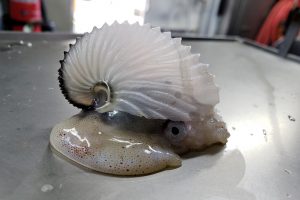
» View recorded webinar (subtitles available in Spanish and English)
Resources to access at home:
» Northeast Fisheries Science Center: Explore the center that the Woods Hole Lab and Aquarium belong to.
» Woods Hole Science Aquarium: Meet the residents, the history of the aquarium, and more. Test your knowledge by taking these quizzes about marine mammals, invertebrates, sea turtles, ocean processes, and fish & sharks.
» "Woods Hole, MA, Birthplace of NOAA Fisheries" and "NOAA Fisheries Birthplace Celebrates 150th Anniversary: NOAA Fisheries Science Shines On in the Northeast" web stories
» Coasts, Oceans, and Stewardship Program (COAST): Lesson plans for teachers based on research at the Northeast Fisheries Science Center.
» Northeast Fisheries Science Center Sounds Page: Listen to the underwater sounds of marine mammals, fish, and humans.
» R/V Gloria Michelle Home Page
» NOAA Ship Henry B. Bigelow Home Page
» National NOAA Fish Age and Growth Page and NOAA's Northeast Fisheries Science Center's (NEFSC) Age and Growth Studies in the Northeast
» Would you like to determine the age of fish using otoliths? (Learn how during the webinar) Visit the NOAA NEFSC otolith reference collection to look at haddock or shad ear bones, make your guess, and then click on the "show annotated" button to see the answer.
Tuesday, March 9, 3 pm ET/11 am AKT
How Old Is That Fish? And What Fish Ear Stones Can Tell Us with Craig Kastelle, NOAA Fisheries Alaska Fisheries Science Center in Seattle, WA
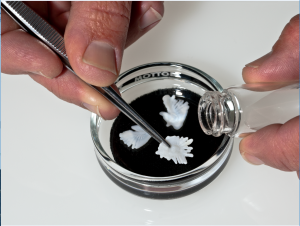
» View recorded webinar (coming soon - subtitles available in Spanish and English)
The webinar will also be live-streamed on Facebook Live on the NOAA Fisheries Alaska Facebook page - @NOAAFisheriesAK
Resources to access at home:
» National NOAA Fish Age and Growth Page and Alaska Age and Growth Procedures for Otolith Examination
» Fish Age and Growth Research in Alaska
» Microworlds: How Old is a Fish? - video
» Microworlds: What do Marine Mammals Eat? - video
Wednesday, March 10, 3 pm ET (Special time this week)
March 2021 Open House Series
From Eyes in the Sky to Action on the Ground at NOAA’s Satellite Operations Facility in Suitland, MD
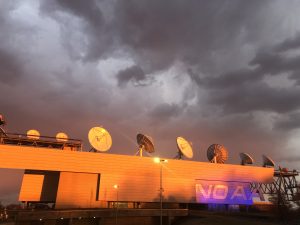
» View recorded webinar (subtitles available in Spanish and English)
Resources to access at home:
» 1 minute NOAA satellites video: This is a great video that explains the difference between polar orbiting satellites, geostationary satellites, and deep space satellite.
» Making a Weather Forecast with GOES-R: This animated, kids video is about 3 1/2 minutes long.
» GOES-R Gets Launched!: This animated, kids video is ~2 minutes long.
» Introduction to Copas-Sarsat: This 1-minute video is about a satellite-based search and rescue distress alert detection system.
» NASA Launches NOAA Weather Satellite to Improve Forecasts (JPSS-1 Launch) (Credit: NASA): 5-minute video of the launch
» NOAA Ocean Today: This 3-minute video is about NOAA's environmental satellites that provide data from space.
» See actual live data from NOAA satellites:
https://rammb-slider.cira.colostate.edu/
https://www.star.nesdis.noaa.gov/goes/
Tuesday, March 16, 3 pm ET/11 am AKT
Cold Dark Secrets: Discovering Alaska’s Deep-Sea Corals and Sponges with Pam Goddard, Vanessa Lowe, Rachel Wilborn, Pat Malecha, and Jerry Hoff at NOAA Fisheries Alaska Fisheries Science Center in Seattle, WA
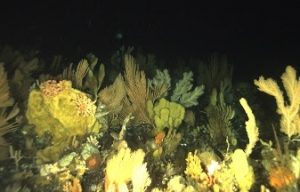
» View recorded webinar (subtitles available in Spanish and English)
The webinar will also be live-streamed on Facebook Live on the NOAA Fisheries Alaska Facebook page - @NOAAFisheriesAK
Resources to access at home:
» Deep-Sea Corals and Sponges of Alaska (Story Map)
» Deep-Sea Corals and Sponge Research in Alaska
» Coral Forests of the Deep (2 min video)
» Deep-Sea Coral Habitats (National)
» NOAA Deep-Sea Coral Data Portal (Digital Map & Database - Worldwide)
» National Marine Sanctuaries (America’s West Coast)
Wednesday, March 17, 4 pm ET
 March 2021 Open House Series
March 2021 Open House Series
Dive into NOAA's Monterey Bay National Marine Sanctuary at the Sanctuary Exploration Center in Santa Cruz, CA

» View recorded webinar (subtitles available in Spanish and English)
Resources to access at home:
» NOAA National Marine Sanctuary Video: The Pacific Leatherback Sea Turtle (~8 minutes long)
» NOAA Monterey Bay National Marine Sanctuary (MBNMS) Virtual Dive Gallery: Sea lions swim through the kelp, sea of orange cucumbers, and more.
» MBNMSS Virtual Dive Scavenger Hunt: This is a fun activity for kids.
» Learn More About Deep-Sea Habitats on the West Coast
» MBARI Listening Room: Access to a live stream and library of recorded underwater sounds
» Davidson Seamount: Oasis in the Deep: Explore an Octopus garden and whale fall in this story and accompanying videos
» Dive in and find the National Marine Sanctuary closest to you
Tuesday, March 23, 3 pm ET/11 am AKT
Hitching a Ride: How to Spot and Stop Marine Invasive Species with Jasmine Maurer from NOAA's Kachemak Bay National Estuarine Research Reserve in Kachemak Bay, AK

» View recorded webinar (subtitles available in Spanish and English)
The webinar will also be live-streamed on Facebook Live on the NOAA Fisheries Alaska Facebook page - @NOAAFisheriesAK
Resources to access at home:
» Community Monitoring - Kachemak Bay National Estuarine Research Reserve
» Invasive Species - Alaska Department of Fish and Game
» Stop Aquatic Hitchhikers!
» Invasive Species - U.S. Fish and Wildlife Service
» Kachemak Bay Environmental Education Alliance - Grab & Go Educational Resources
» Invasive and Exotic Marine Species - NOAA Fisheries
» What is an Invasive Species? - NOAA's National Ocean Service (video)
Wednesday, March 24, 4 pm ET
 March 2021 Open House Series
March 2021 Open House Series
NOAA's Nose Knows: A day in the life of a Seafood Inspector with NOAA's Seafood Inspection Facility in Long Beach, CA

» View recorded webinar (subtitles available in Spanish and English)
Resources to access at home:
» Contact Your Local Seafood Inspection Office
» Fishwatch.gov: Find out what makes U.S. seafood sustainable and get up-to-date information on the status of some of the fish harvested and farmed in the U.S.
» Seafood Commerce & Certification Site: There are several feature stories about seafood testing, the seafood inspection services portal where people sign up for an inspection and more
» NOAA Fisheries: Fun Facts about Luscious Lobsters. This includes "If lobsters mole, why have I never seen a cast-off shell", "How old is a one-pound lobster", "What color is a lobster's blood", and more!
» Virtually explore the deep sea by scrolling down to discover which animals and plant life live at which depths in the oceans.
Tuesday, March 30, 3 pm ET/11 am AKT
 March 2021 Open House Series
March 2021 Open House Series
A Dive Into Daily Life at the Alaska Fisheries Science Center's Kodiak Lab in Kodiak, AK
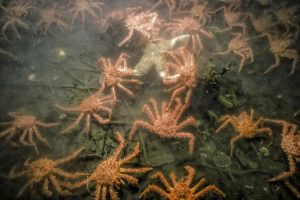
» View recorded webinar (subtitles available in Spanish and English)
The webinar will also be live-streamed on Facebook Live on the NOAA Fisheries Alaska Facebook page - @NOAAFisheriesAK
Resources to access at home:
» A View From Inside the Kodiak Lab Aquarium - science blog
» NOAA Live! Alaska webinar - The Crab-tivating Life of Crustaceans
» Ocean Science Discovery Program
» Meet Switgard Duesterloh - Alaska Ocean Acidification Network
Wednesday, March 31, 4 pm ET
 March 2021 Open House Series
March 2021 Open House Series
Science in the Sky: How NOAA's Aircraft Operations Center supports research from 500 to 45,000ft in Lakeland, FL
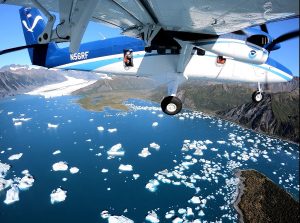
» View recorded webinar (subtitles available in Spanish and English)
Resources to access at home:
» NOAA Marine and Aviation Operations captioned tours of aircraft: P-3, G-IV, Twin Otter, and King Air (each is 10-15 minutes long).
» NOAA Commissioned Corps
» Past NOAA Live! Webinar recording: Hunting Hurricanes with a NOAA Pilot
Wednesday, April 7, 4 pm ET
Kelp Farming in Coastal Waters with Anoushka Concepcion, NOAA's Connecticut Sea Grant in Groton, CT in partnership with Holly Turner-Moore, Bridgeport Regional Aquaculture Science and Technology Education Center in Bridgeport, CT
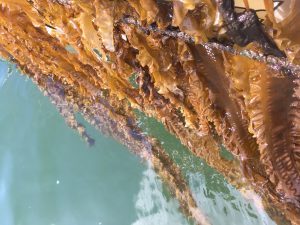
» View recorded webinar (subtitles available in Spanish and English)
Resources to access at home
» NOAA Fisheries Aquaculture Materials: Fact sheets, FAQs, videos, and more
» NOAA Ocean Today Every Full Moon: The Future of Ocean Farming. This series of short videos give a great introduction to marine aquaculture or ocean farming. Bonus video 2 is focused on Alaska Kelp Farming
» NOAA infographic: Aquaculture grows resilient coastal communities. The infographic is a nice visual showing oyster, mussel, and algae aquaculture methods that generate local seafood, improve water quality, protect against storm surge, and provide essential habitat.
» Bridgeport Regional Aquaculture Science and Technology Education Center in CT
Tuesday, April 13, 3 pm ET/11 am AKT
What do you know about Alaska salmon? Exploring the job of a salmon biologist with Joshua Russell, NOAA Fisheries Alaska Fisheries Science Center in Juneau, AK
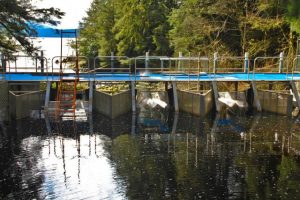
» View recorded webinar (subtitles available in Spanish and English)
The webinar will also be live-streamed on Facebook Live on the NOAA Fisheries Alaska Facebook page - @NOAAFisheriesAK
Resources to access at home:
» Alaska Native Science and Engineering Program (ANSEP)
» Annual Study of Salmon in Southeast Alaska - science blog» Stop Aquatic Hitchhikers!
» Alaska Salmon Travels - science blog
» Yukon River Salmon Survey - science blog
» Salmon Research in Alaska
» Alaska Native Women in Bristol Bay Salmon Fisheries - science blog
» Auke Creek Research Station
» Alaska Fisheries Science Center Auke Bay Laboratories
Wednesday, April 14, 4 pm ET
Texas Corals, and Mantas, and Sharks, Oh My! with Kelly Drinnen, NOAA's Flower Garden Banks National Marine Sanctuary in Galveston, TX

» View recorded webinar (subtitles available in Spanish and English)
Resources to access at home:
» Flower Garden Banks National Marine Sanctuary: For Teachers - Curriculum, lessons, activities, and posters
» Flower Garden Banks National Marine Sanctuary: For Kids - Did You Know?, word puzzles, activities, holiday fun
» Flower Garden Banks National Marine Sanctuary: Coral Basics
» Dive in and find the National Marine Sanctuary closest to you
» Flower Garden Banks National Marine Sanctuary Coral Reef Word Search used in the webinar.
» Relevant NOAA Live! Webinars: "Dive In and Explore Coral Reef Ecosystems"
» Flower Garden Banks National Marine Sanctuary species list
» Flower Garden Banks National Marine Sanctuary videos of reef creatures
» Stories from the Blue: Lt. Dustin Picard: This 4-minute video features diving in Flower Garden Banks National Marine Sanctuary
Tuesday, April 20, 3 pm ET/11 am AKT
Breaking Up is Hard To Do: River Ice Breakup in Alaska with Crane Johnson, NOAA's National Weather Service Alaska Pacific River Forecast Center in Anchorage, AK
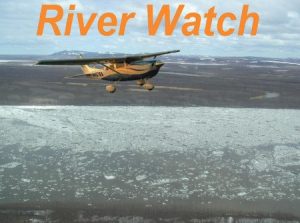
» View recorded webinar (subtitles available in Spanish and English)
The webinar will also be live-streamed on Facebook Live on the NOAA Fisheries Alaska Facebook page - @NOAAFisheriesAK
Resources to access at home:
» Citizen Science: Local Environmental Observer (LEO) Network
» NOAA's National Weather Service - Educational Resources
» NOAA's National Weather Service - River Watch Program
Wednesday, April 21, 4 pm ET
NOAA Buoys Around the World with Lieutenant Lauren Jarlenski and Dawn Petraitis, NOAA's National Data Buoy Center at the Stennis Space Center in Kiln, MS
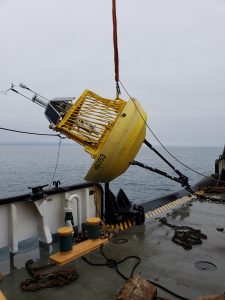
» View recorded webinar (subtitles available in Spanish and English)
Resources to access at home:
» Chesapeake Bay Interpretive Buoy System (CBIBS): While CBIBS is not managed by the National Data Buoy Center, this network of NOAA buoys collects similar data. You can learn about buoys, graph data from this buoy system, connect with the Captain John Smith Chesapeake National Historic Trail (if kayaking near the buoys), or investigate data in your classroom.
» Build a Buoy: This classroom or home project allows you to build your own functional buoy - a junior cousin to NOAA's data buoys- using materials from a hardware store. More detailed instructions can be found here.
» NOAA Live! connections: You heard about hurricanes and tsunami in this webinar. Learn more by watching our "Getting Prepared for Hurricane Season", "Not Your Friendly Neighborhood Wave", or "Minutes Matter: Nature's Warning Signs for Tsunami".
Tuesday, April 27, 3 pm ET/11 am AKT
Needle in a haystack: Studying the world’s rarest large whale with Dana Wright, University of Washington, Cooperative Institute for Climate, Ocean, and Ecosystem Studies (CICOES) and Duke University Marine Laboratory, working with NOAA Fisheries Alaska Fisheries Science Center in Seattle, WA
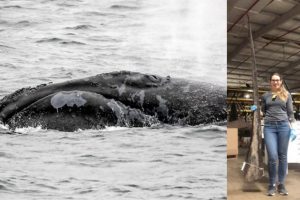
» View recorded webinar (subtitles available in Spanish and English)
The webinar will also be live-streamed on Facebook Live on the NOAA Fisheries Alaska Facebook page - @NOAAFisheriesAK
Resources to access at home:
» Understanding Why North Pacific Right Whales Are Endangered
» Interesting Facts About North Pacific Right Whale
» North Pacific Right Whale Research in Alaska
» North Pacific Right Whale - fact sheet
» First Recording of North Pacific Right Whale Song
» Spotlight on the North Pacific Right Whale - An Interview with NOAA Fisheries Marine Mammal Scientist Jessica Crance - video
» 'Song' of Rare Whale Recorded for the First Time - CNN
» New Study Sheds Light on Mysterious Movements of Rarest Great Whale
Wednesday, April 28, 4 pm ET
Fin-tastic Fun with Coral Reef Fish Surveys in South Florida and the Caribbean with Erin Cain and Jay Grove, NOAA's Southeast Fisheries Science Center in Key Biscayne, FL
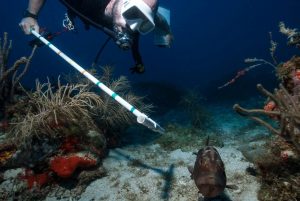
» View recorded webinar (subtitles available in Spanish and English)
Resources to access at home:
» The Coral Reef Conservation Program's efforts to increase fisheries sustainability
» NOAA's Interactive Reef: As you run your mouse over this image, species will light up and you can click on them to open a feature page with an image and information.
» NOAA's Activity Book on coral reefs: This activity booklet is aimed at grades 3-5.
» NOAA's Fishwatch.gov: Get the most up-to-date info on popular seafood harvested or farmed in the US to help you made educated seafood choices.
» NOAA's National Coral Reef Monitoring Program Status Reports: Referenced in the webinar, you can find the most recent status report on the coral reefs at Flower Garden Banks, Florida, Puerto Rico, U.S. Virgin Islands, and Pacific locations.
» What you can do to help coral reefs?
Tuesday, May 4, 3 pm ET/11 am AKT
One Fish, Two Fish, This Fish, Not That Fish with Noelle Yochum, NOAA Fisheries Alaska Fisheries Science Center in Seattle, WA, and Michelle Dyroy, Alaska Pacific University in Anchorage, AK
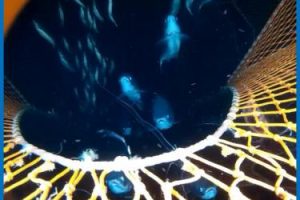
» View recorded webinar (subtitles available in Spanish and English)
The webinar will also be live-streamed on Facebook Live on the NOAA Fisheries Alaska Facebook page - @NOAAFisheriesAK
Resources to access at home:
» Loggerhead Escape: This National Geographic activity is for grades 4-11.
» Fishing Gear: Turtle Excluder Devices
» History of Turtle Excluder Devices
» Turtle Excluder Devices - video
» Tackling Bycatch in U.S. Fisheries - video
» What is a Barbless Circle Hook?
» NOAA's National Bycatch Reduction Strategy
Wednesday, May 5, 4 pm ET
Get Your Feet Muddy at the Waquoit Bay Reserve! with Tonna-Marie Rogers, NOAA's Waquoit Bay National Estuarine Research Reserve in Falmouth, MA

» View recorded webinar (subtitles available in Spanish and English)
Resources to access at home:
» WBNERR's STEM curriculum for teachers: This includes the "Bringing wetlands to market: a STEM curriculum linking wetlands and climate change", the "Sentinel site lesson plan booklet", and more.
» Find a National Estuarine Research Reserve (NERR) near you
» NOAA's NERR Estuary Education Website: This has activities for students, teacher workshops, videos, and more!
» Virtual Estuary Education for students and families: This includes virtual field trips, science crafts, nature journaling in your backyard, and more!
» WBNERR water quality data: WQBMHWQ station and WQBMHWQ station (scroll to the bottom of the page to find these stations)
» Wampanoag "Preserving our Homelands" video
Tuesday, May 11, 3 pm ET/11 am AKT
Algal Blooms: Signs of Spring and Signs of Trouble with Rose Masui, NOAA's Kachemak Bay National Estuarine Research Reserve in Kachemak Bay, AK
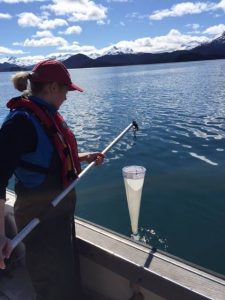
» View recorded webinar (subtitles available in Spanish and English)
The webinar will also be live-streamed on Facebook Live on the NOAA Fisheries Alaska Facebook page - @NOAAFisheriesAK
Resources to access at home:
» Kachemak Bay National Estuarine Research Reserve
» KBNERR Community Monitoring Program
» What is a harmful algal bloom?
» Harmful Algal Blooms: Tiny Organisms with a Toxic Punch
» What is a red tide? (it's a common term used for a harmful algal bloom) - video
» Hitting us where it hurts: the untold story of harmful algal blooms - storymap
» Harmful Algae - Resources for educators (grades 6-12), Woods Hole Oceanographic Institution
» Video from the webinar: Phytoplankton bloom
» Video from the webinar: KNBERR Phytoplankton tow tutorial
» Video from the webinar: A decade of phytoplankton blooms in the North Pacific - NOAA Climate.gov
Please contact Lisa.Hiruki-Raring@noaa.gov for more information.
Wednesday, May 12, 4 pm ET
Lessons from Lake Trout in Lake Champlain with Ashley Eaton and Caroline Blake, NOAA's Lake Champlain Sea Grant in Burlington, VT
Lake Champlain, known as Bitawbakw by the Abenaki people, is home to lake trout. As one of the top predators in Lake Champlain, they play an important role in maintaining balance within the lake ecosystem. When lake trout populations struggled, it took coordinated efforts to contain sea lamprey to help them recover. Management of sea lamprey has greatly reduced stress of lake trout and since 2015 lake trout populations have been slowly recovering. Join us to learn the heroic tale of the Lake Champlain lake trout, and the efforts that inform conservation of this important freshwater species! (Live ASL interpretation)
» View recorded webinar (subtitles available in Spanish and English)
Resources to access at home:
» Nebi: Abenaki Ways of Knowing Water | Lake Champlain Sea Grant: This video is mentioned in the webinar (~10 minute long)
» Zoom a Scientist: A fish's story: following lake trout movement around Lake Champlain (~50 minute long webinar)
» Fish Files - Lake Trout (~3 minute long video)
» Fish Files - Lake Trout Dissection (video)
» Fashion a Fish: This activity is aimed at students K-5
Tuesday, May 18, 3 pm ET/11 am AKT
Fishy Business: NOAA Office of Law Enforcement and Healthy Resource Management with Alex Perry, Wynn Carney, and Amy Anderson, NOAA Office of Law Enforcement in Anchorage, AK

» View recorded webinar (subtitles available in Spanish and English)
Resources to access at home:
» NOAA Enforcement Deploys Remotely Operated Vehicles to Patrol the Seas
» Introduction to NOAA's Office of Law Enforcement - video
» NOAA Law Enforcement Investigative Work - video
» Cracking the Research Set-Aside Case - video
Wednesday, May 19, 4 pm ET
Forecasting for the Navajo Nation: Learning the Landscape, Culture & Language with Tony Merriman, NOAA's National Weather Service in Flagstaff, AZ and Doug Watchman, Navajo Nation Department of Emergency Management in Window Rock, AZ
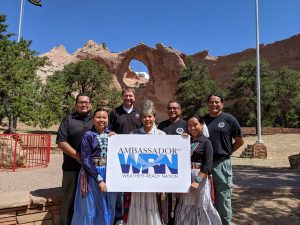
» View recorded webinar (subtitles available in Spanish and English)
Resources to access at home:
» NWS Navajo storm pattern rug weather poster: This poster includes both cultural and linguistic information
» Guide to the Navajo Nation Seal (YÁ ’ ÁT ’ ÉÉH): This lesson is courtesy of the Central Consolidated School District, Shiprock, NM
» Ní’tsíí Níłtsą́ Yaahaalne’ - Hair Tells the Weather (Bilingual Navajo & English): Science isn’t all about numbers. In 2017 the National Weather Service learned of the importance of the Navajo Tsiiyéeł and the relationship with weather. This video is about 3 1/2 minutes long.
» NWS experimental weather dashboards for tribal lands (these are referenced in the webinar)
Tuesday, May 25, 3 pm ET/11 am AKT
North to the Future: Alaskan sharks in a changing ocean with Cindy Tribuzio, NOAA Fisheries Alaska Fisheries Science Center in Juneau, AK, and Sabrina Garcia, Alaska Department of Fish and Game in Anchorage, AK
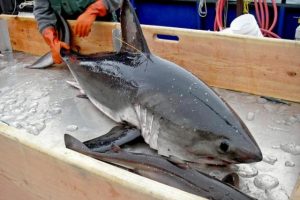
» View recorded webinar (subtitles available in Spanish and English)
Resources to access at home:
» NOAA Fisheries - Fish and Sharks webpage
» Fun Facts about Shocking Sharks
» Shark Research in Alaska: NOAA Fisheries
» Alaska Department of Fish and Game - The Undersea World of Salmon and Sharks (@ADFGUnderseaWorldOfSalmonAndSharks): Facebook page with exciting scientific research on Alaskan salmon, sharks, and their ecosystems and ecology!
» Salmon Shark Tagging in the Bering Sea: Alaska Fish & Wildlife News
» Gills Club: STEM-based education initiative dedicated to connecting girls with female scientists around the world to inspire shark and ocean conservation
Wednesday, May 26, 4 pm ET
Fresh Coasts: Where Food Grows Wild on the Water with Jennifer Ballinger, Brandon Krumwiede and Heather Stirratt, NOAA's Office for Coastal Management in Chanhassen, MN
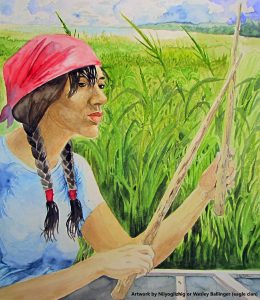
» View recorded webinar (subtitles available in Spanish and English)
Resources to access at home:
» NOAA article: Spotlight on People and Pollution: Wild rice, pollution, and space for traditions to grow
» NOAA article: Sea Grant and partners work together to restore culturally important wild rice
» NOAA article: Restoring and Monitoring Lake Superior Coastal Wetland Manoomin
» NOAA 1-minute video on coastal management (it was used in the webinar)
» PBS Wisconsin Education video: This ~4-minute video follows Fred Ackley Jr. from the Sokaogon Chippewa Community of Mole Lake as he harvests and processes manoomin, or wild rice.
Tuesday, June 1, 3 pm ET/11 am AKT
Forecasting the Weather in Southcentral Alaska with Kaitlyn O'Brien, NOAA's National Weather Service in Anchorage, AK
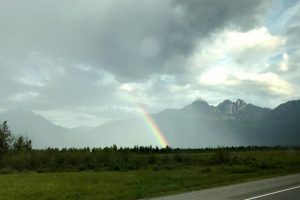
» View recorded webinar (subtitles available in Spanish and English)
» Alaska Weather - NOAA National Weather Service Alaska Region
» Southcentral Alaska Weather - NWS Anchorage Forecast Office
» NWS River Forecast Center
» NWS Aviation Weather Unit
» NWS National Tsunami Warning Center
» NWS - Educational resources
» Jetstream - NWS Online School for Weather»
» NOAA Education - Weather and Atmosphere resource collection
» NOAA Education - Weather Observations
» Citizen Science: Local Environmental Observer (LEO) Network
» Citizen Science: CoCoRaHS - Community Collaborative Rain, Hail & Snow Network
Wednesday, June 2, 4 pm ET
Charting a Career with the NOAA Corps with NOAA's Commissioned Corps Officers in multiple locations across the U.S.
» View recorded webinar (subtitles available in Spanish and English)
Resources to access at home:
» NOAA Commissioned Officer video (approx 20 min)
» Women of the NOAA Corps (approx 30 min)
» Bac
» Stories from the Blue: Lt. Dustin Picard: This 4-minute video features one of the NOAA Corps officers from the webinar
Tuesday, June 8, 3 pm ET/11 am AKT
Northern Exposure: a NOAA Corps Officer's Work in Alaska with Commander Sarah Duncan, NOAA's Pacific Marine Environmental Laboratory in Seattle, WA
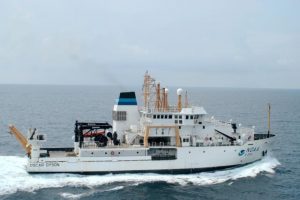
» View recorded webinar (subtitles available in Spanish and English)
Resources to access at home:
» NOAA Office of Marine and Aviation Operations
» Meet the Crew: Commander Sarah Duncan, NOAA Ship Oscar Dyson
» NOAA Commissioned Officer Corps - Virtual NOAA Day at the Aquarium of the Pacific - meet LTJG Chelsea Parrish, Cetacean Photogrammetry Specialist
» Women of the NOAA Corps: Reflections from the Sea and Sky - 30 minute video
» NOA Ocean Today Video - Life at Sea - meet Allison Stone, hydrographic senior survey technician on the NOAA ship Thomas Jefferson
» Meet the Crew: Chief Boatswain Leslie Allen, NOAA Ship Fairweather
» NOAA Corps overview
» NOAA Corps History
Wednesday, June 9, 4 pm ET
Killer Whale Tales: Environmental Science through Storytelling with Lynne Barre, NOAA Fisheries West Coast Regional Office and Jeff Hogan, Killer Whale Tales in Seattle, WA
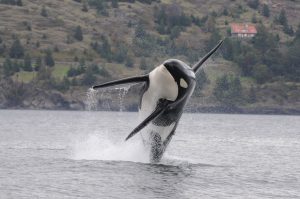
(Live ASL interpretation)
» View recorded webinar (subtitles available in Spanish and English) and the datasheet used during the webinar
Resources to access at home:
» Saving the Southern Resident Killer Whales NOAA website: This includes an introduction to southern resident orcas, threats they face such as contaminants, vessel noise, and prey availability, and the work being done on recovery of the species
» Killer Whale Tales Activity Guide and Orca Research Sheets: This has a word search, turn your family tree into a pod, fun facts, behavioral datasheets, and more.
» NOAA Fisheries Orca Outreach and Education Materials: This website includes a fin matching activity, be whale wise poster, and how to take action.
Wednesday, June 16, 4 pm ET SPECIAL BONUS WEBINAR - WHOI Live!
A Strange and Mysterious Hidden World: The Ocean Twilight Zone with Lyndsey Lefebvre, Woods Hole Oceanographic Institution in Woods Hole, MA

(Live ASL interpretation)
» View recorded webinar (subtitles available in Spanish and English)
Resources to access at home:
» Dive and Discover Expedition 17 - the Ocean Twilight Zone
» What is the twilight zone?
» Woods Hole Oceanographic Institution (WHOI) K-12 page: This website has images, illustrations, coloring pages, items for teachers, and more.
» Dive and Discover Program Home page: Find information on all of the previous expeditions here!
» Find your "weird" quiz: This WHOI quiz will assign you an OTZ creature based on your answers
» WHOI creature features: Find out more about the unique animals Lyndsey shared with us. Siphonophore, Bristlemouth, Sloane's Viperfish, Strawberry Squid, Anglerfish, Hatchetfish, Pelican Eel, and Atolla jellyfish
» WHOI Technology in the Ocean Twilight Zone: Stingray, Deep-See, and Mesobot.
Contact:
Grace Simpkins
Woods Hole Sea Grant Educator
gsimpkins@whoi.edu
Nicole Bartlett
North Atlantic Regional Coordinator
nicole.bartlett@noaa.gov

